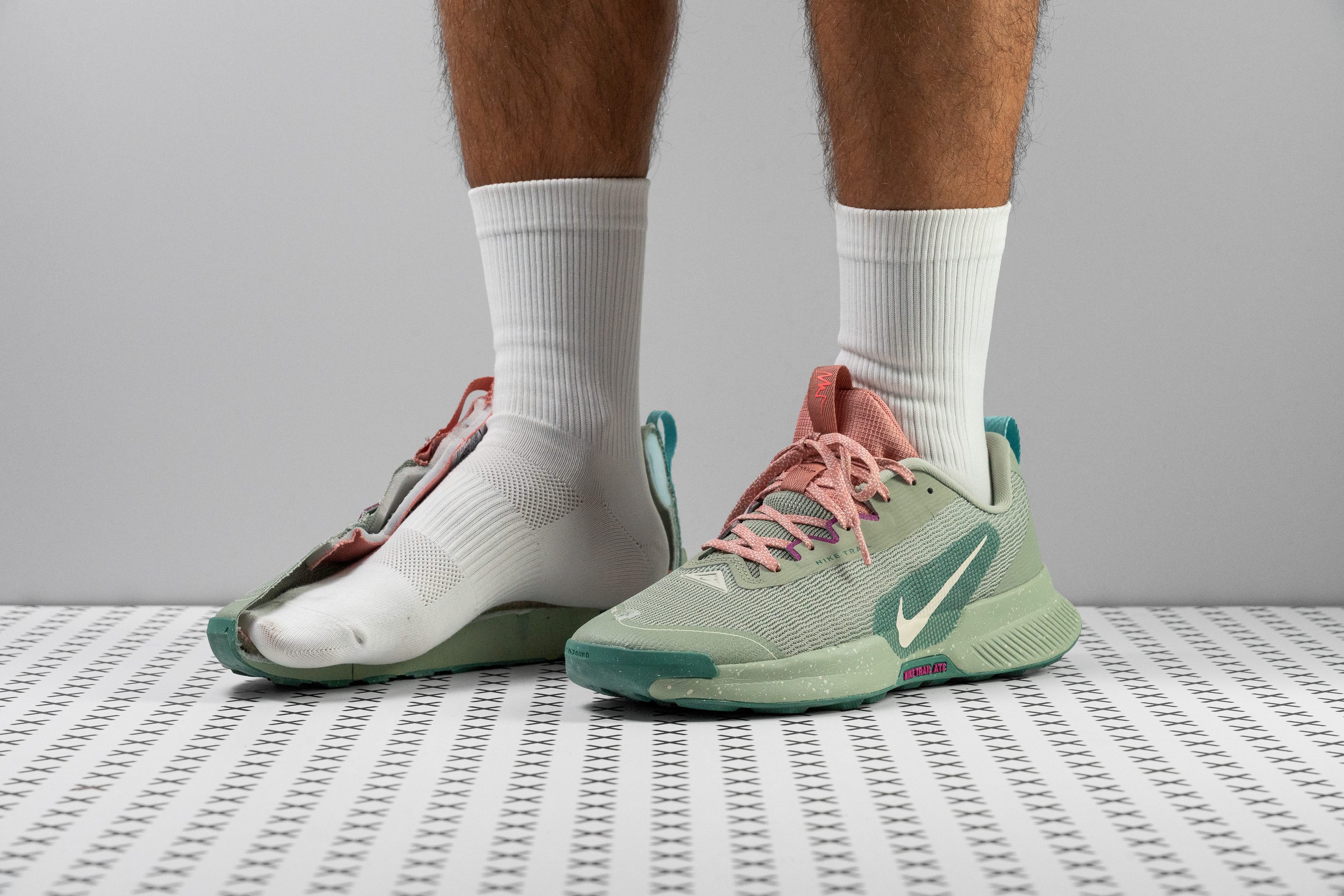Our verdict
Pros
- Wallet-friendly pricing
- Enhanced midsole cushioning
- Heel-striker optimized design
- Spacious toebox
- Closer than ever to the Peg Trail
- Upgraded midsole
- All-terrain versatility
- Reflective elements
- Good grip
Cons
- Reduced stack height compared to v2
- Not the best for forefoot strikers
- Limited breathability
Audience verdict
Comparison
The most similar running shoes compared
+ + Add a shoe | |||||
|---|---|---|---|---|---|
| Audience score | 73 Bad! | 87 Great! | 89 Great! | 76 Decent! | |
| Price | $90 | $100 | $150 | $90 | |
| Trail terrain | Light | Light | Light | Light | |
| Shock absorption | Moderate | Moderate | High | - | |
| Energy return | Low | Low | Moderate | - | |
| Arch support | Neutral | Neutral | Neutral | Neutral | |
| Weight lab Weight brand | 10.2 oz / 288g 10.8 oz / 305g | 8.4 oz / 237g 8.6 oz / 243g | 10.1 oz / 286g 10.1 oz / 286g | 10.7 oz / 302g 9.9 oz / 282g | |
| Lightweight | ✗ | ✓ | ✗ | ✗ | |
| Drop lab Drop brand | 10.9 mm 10.0 mm | 11.0 mm 6.0 mm | 9.6 mm 9.5 mm | 8.0 mm 8.0 mm | |
| Strike pattern | Heel | Heel | HeelMid/forefoot | HeelMid/forefoot | |
| Size | True to size | True to size | True to size | Slightly small | |
| Midsole softness | Balanced | Soft | Soft | Balanced | |
| Difference in midsole softness in cold | Small | Small | Normal | Normal | |
| Toebox durability | Decent | Bad | Very good | Good | |
| Heel padding durability | Bad | Decent | Good | Decent | |
| Outsole durability | Good | Decent | Good | Decent | |
| Breathability | Warm | Moderate | Warm | Breathable | |
| Width / fit | Medium | Narrow | Medium | Medium | |
| Toebox width | Wide | Medium | Medium | Wide | |
| Stiffness | Moderate | Moderate | Moderate | Stiff | |
| Torsional rigidity | Stiff | Stiff | Moderate | Moderate | |
| Heel counter stiffness | Stiff | Flexible | Stiff | Moderate | |
| Lug depth | 2.6 mm | 2.0 mm | 3.2 mm | 2.4 mm | |
| Heel stack lab Heel stack brand | 32.6 mm 32.0 mm | 32.3 mm 26.0 mm | 34.6 mm 37.0 mm | 32.2 mm 32.0 mm | |
| Forefoot lab Forefoot brand | 21.7 mm 22.0 mm | 21.3 mm 20.0 mm | 25.0 mm 27.5 mm | 24.2 mm 24.0 mm | |
| Widths available | Normal | NormalWide | NormalWideX-Wide | NormalWide | |
| Season | All seasons | All seasons | All seasons | SummerAll seasons | |
| Removable insole | ✓ | ✓ | ✓ | ✓ | |
| Orthotic friendly | ✓ | ✓ | ✓ | ✓ | |
| Ranking | #366 Bottom 2% | #149 Top 40% | #88 Top 24% | #350 Bottom 6% | |
| Popularity | #188 Bottom 49% | #291 Bottom 22% | #54 Top 15% | #180 Top 48% |
Who should buy
We believe the Nike Juniper Trail 3 is a top pick for:
- Beginners looking for a reliable, adventure-ready trail shoe with a roomy upper for extra comfort.
- Road runners seeking a budget-friendly option for occasional trail runs or hiking excursions.
- Fans of the previous model who need an upgrade—this version brings multiple enhancements without losing the spacious fit.
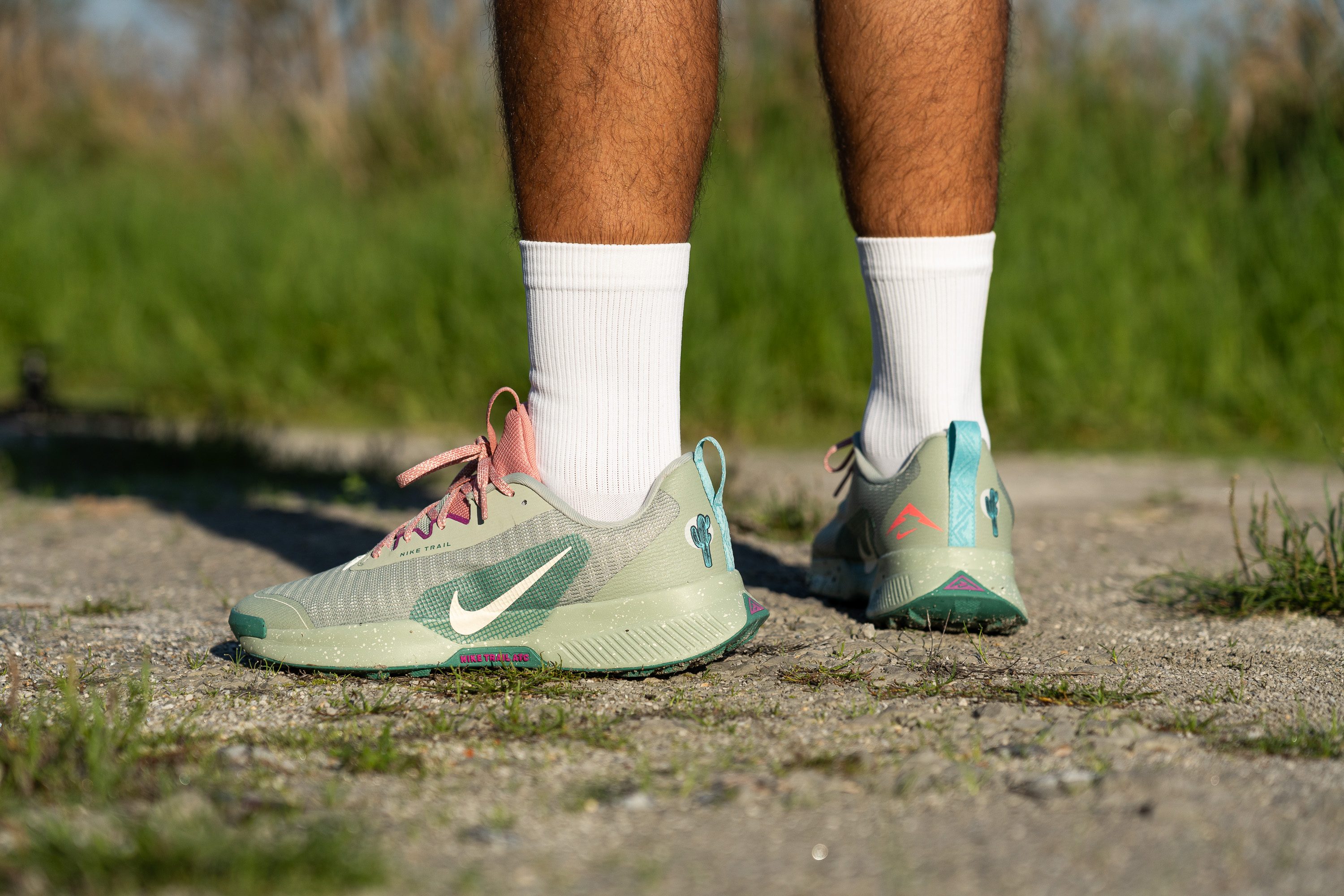
Who should NOT buy
Unfortunately, the Nike Juniper Trail 3 falls short in breathability due to its dense upper—Nike omitted upper ventilation holes, making it uncomfortable for hot-weather runs. We believe that choosing the ASICS Gel Venture 9, with its airy mesh, is a better choice if overheating is a concern.
Additionally, we think the Juniper Trail 3’s wide fit may not suit narrow-footed runners, even when sizing down—which anyway is a less-than-ideal move especially for trail shoes. For those who need a snugger, precision-focused fit, we recommend exploring the Hoka Challenger 7 or Hoka Torrent 3 as superior door-to-trail options.
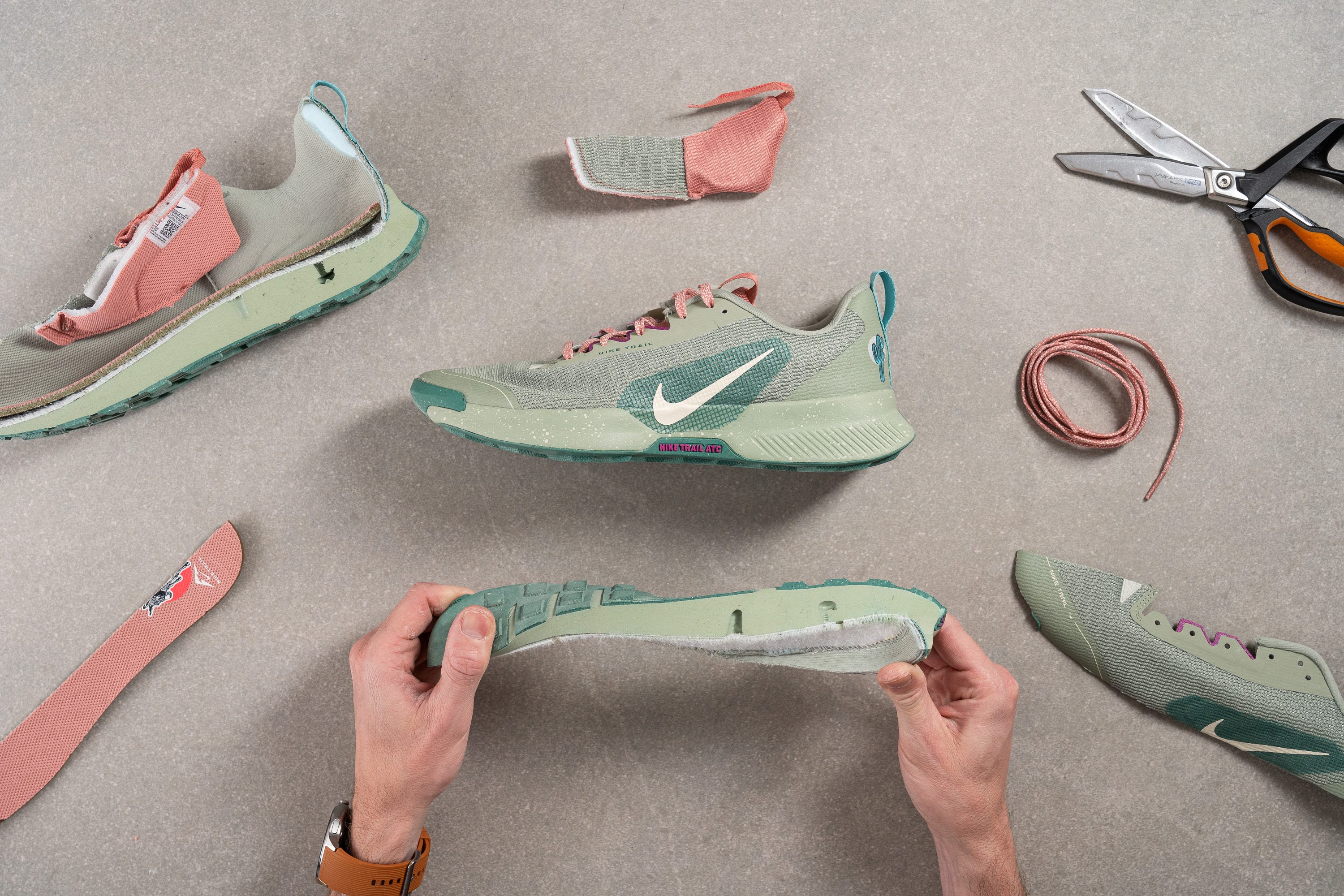
Cushioning
Shock absorption
One clear sign that this shoe is a budget version of Nike’s pricier trail models is its limited forefoot cushioning, with only 83 SA. On the other hand, heel strikers are better supported with a more forgiving 117 SA.
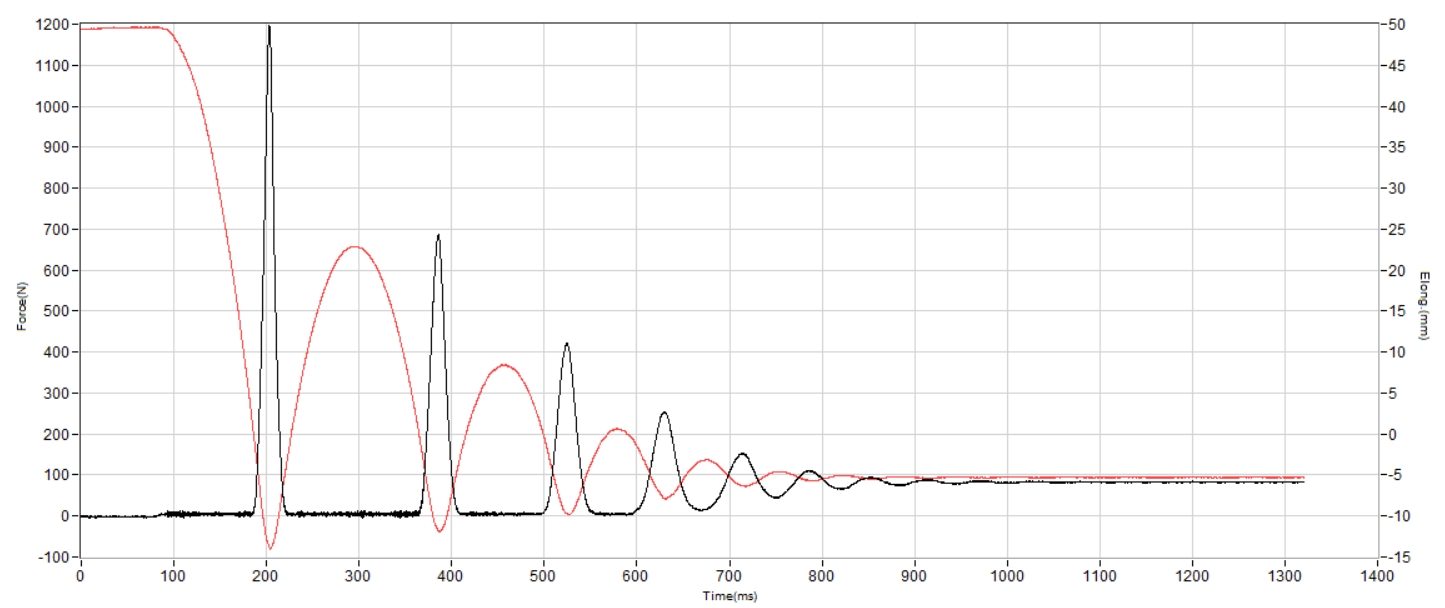
| Juniper Trail 3 | 117 SA |
| Average | 122 SA |
Energy return
We tested the Juniper Trail 3 in the lab and found its energy return surprisingly decent, especially given the budget-friendly price and EVA-based foam. It reached 53.6% in the heel—a result that adds a hint of rebound to the ride.
| Juniper Trail 3 | 53.6% |
| Average | 55.6% |
Heel stack
However, there’s a trade-off here that won’t please everyone—a slight drop in stack height.
The Juniper Trail 2 featured 34.7 mm in the heel, while we measured 32.6 mm in this update. Though it’s a subtle change—good luck feeling a 2.1 mm difference—it still means slightly less cushioning underfoot, which might disappoint those seeking maximum muscle protection in their ride.

| Juniper Trail 3 | 32.6 mm |
| Average | 32.6 mm |
Forefoot stack
The forefoot received the same treatment and it's a bit more concerning, because it barely crosses the 20-mm threshold to stay at just 21.7 mm. That's because the high drop of this shoe, that features a wedge design that clearly suits the shoe better for heel strikers.
In fact, if you're a forefoot striker, we think this is not the best pick for you. Check the Hierro 8 from New Balance instead.
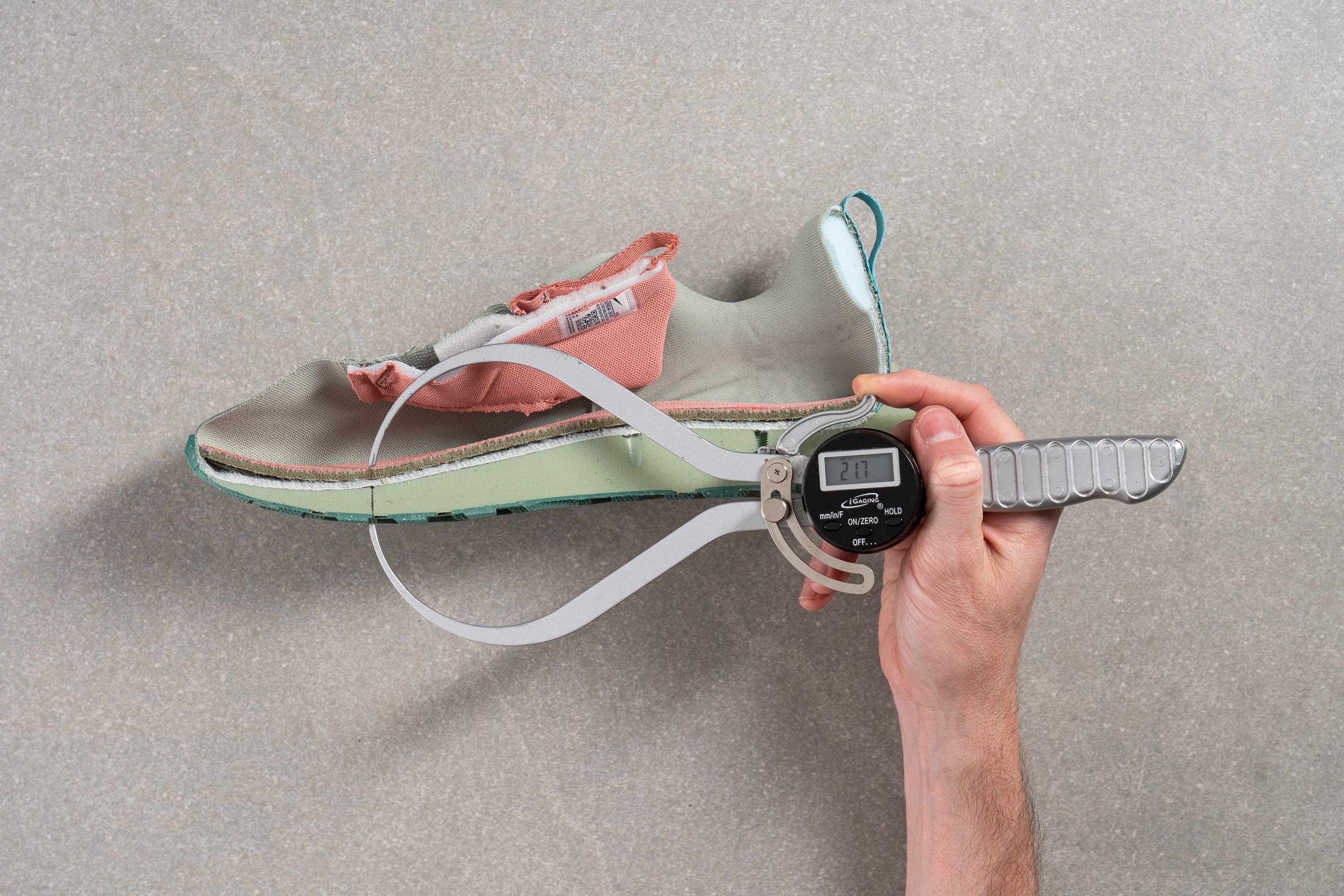
| Juniper Trail 3 | 21.7 mm |
| Average | 25.1 mm |
Drop
As we noted earlier, the Juniper Trail 3 has a wedge-like design with a pronounced incline from the midfoot to the forefoot, making it ideal for heel strikers. Not many trail shoes exceed a 10 mm drop, but this one stands out with a huge 10.9 mm!
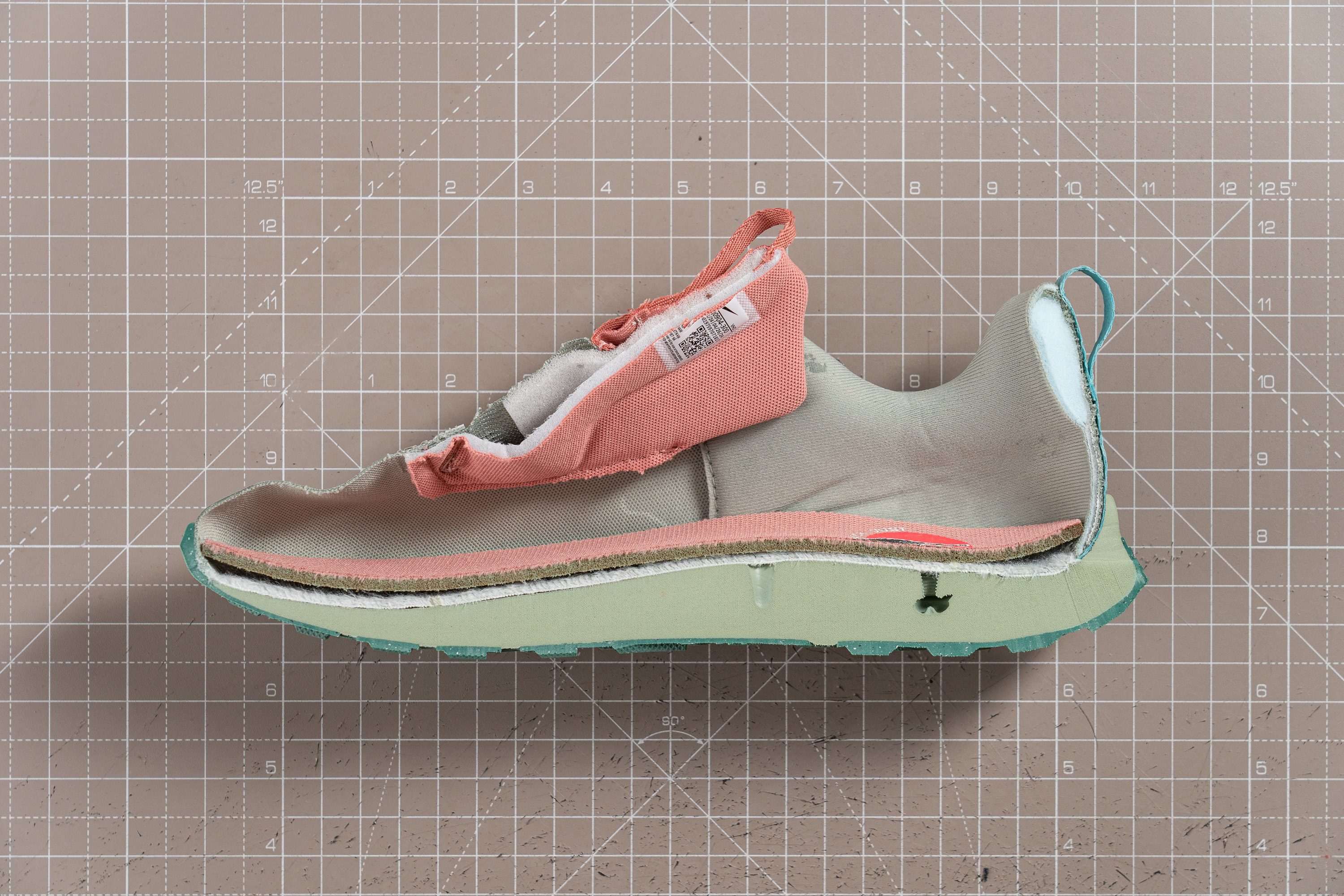
| Juniper Trail 3 | 10.9 mm |
| Average | 7.5 mm |
Midsole softness
The biggest reason to upgrade from the Juniper Trail 2 to the 3 is the improved foam. While the previous model used a basic-and-boring EVA that felt overly firm at 27.1 HA, this new version introduces Nike’s ComfiRide—a softer, more forgiving foam that we measured at 23.0 HA.
So, what exactly is ComfiRide? It’s Nike’s latest budget-friendly foam, also seen in models like the Journey Run, and we definitely noticed the comfort boost. However, don’t expect a lively bounce or high energy return, as it’s still EVA.
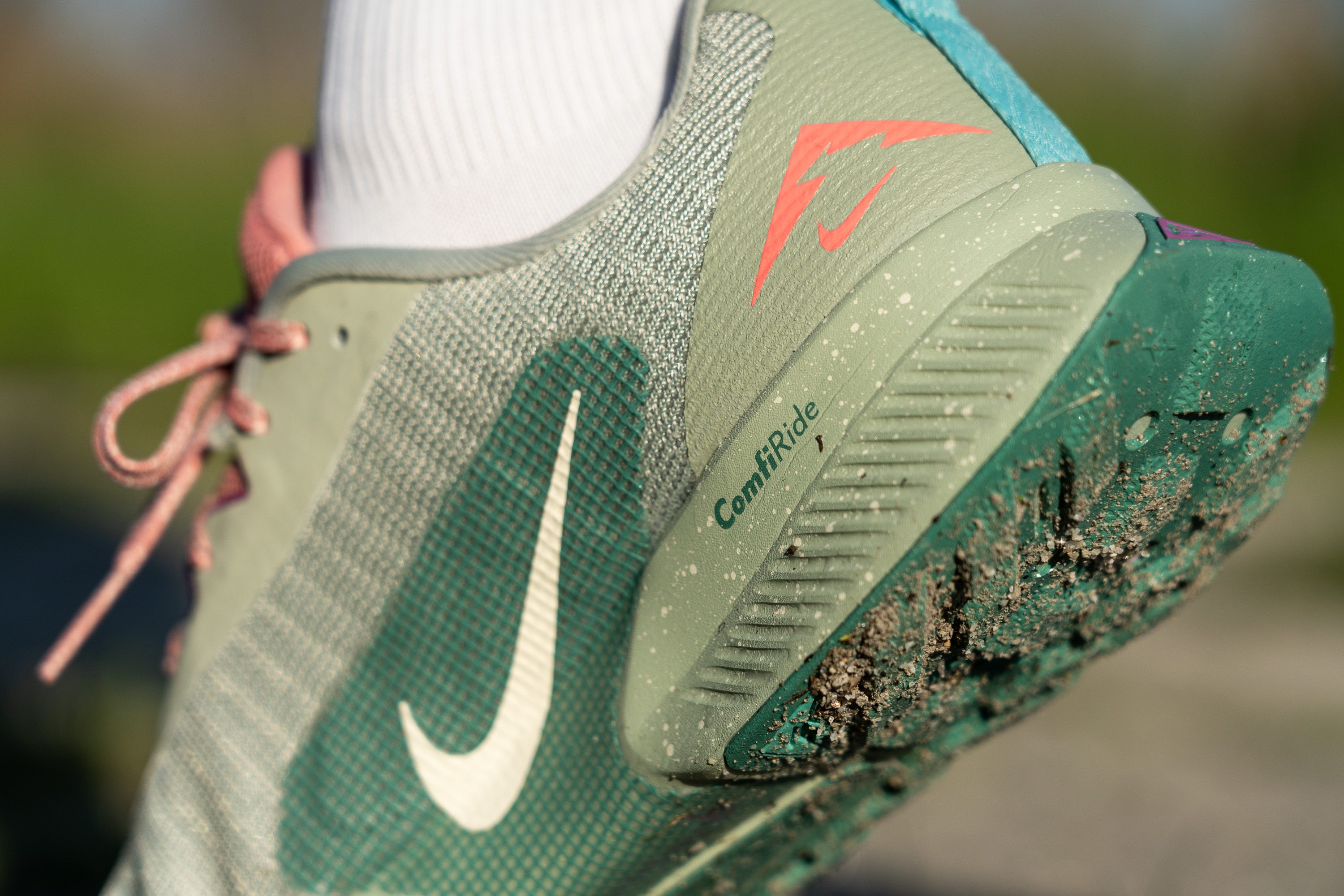
In fact, Nike oversold the plushness of this foam on its PR, we have no doubt about that. Yes, it’s a step up from previous EVA formulations, but it doesn’t quite reach the luxurious feel suggested by Nike's claims.
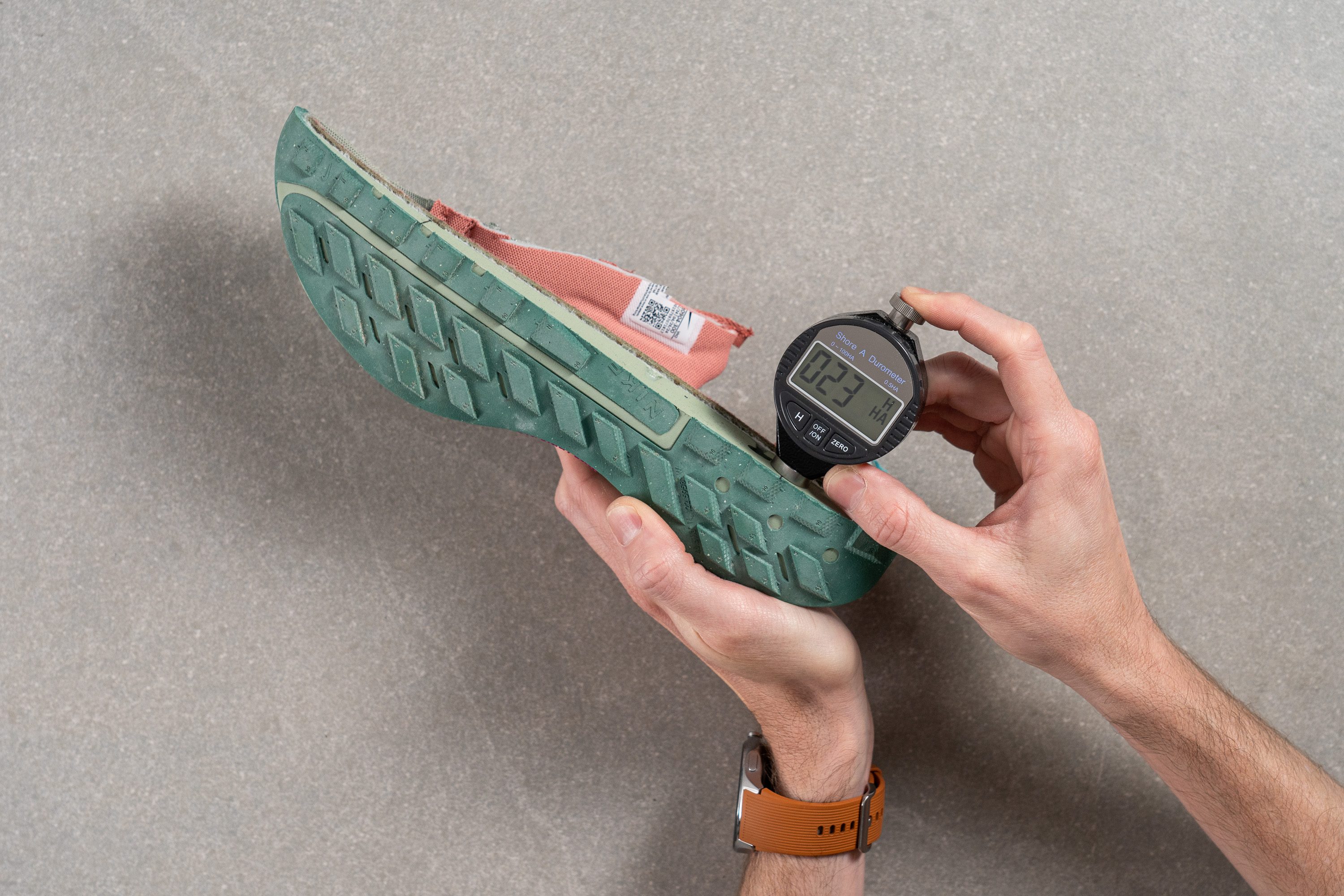
| Juniper Trail 3 | 23.0 HA |
| Average | 21.9 HA |
Rocker
Rockered shoe enthusiasts should steer clear of the Juniper Trail 3, which sports a flat, traditional midsole without pronounced curvature. However, we appreciate this design for this shoe—it complements the high drop and adds versatility for hiking.
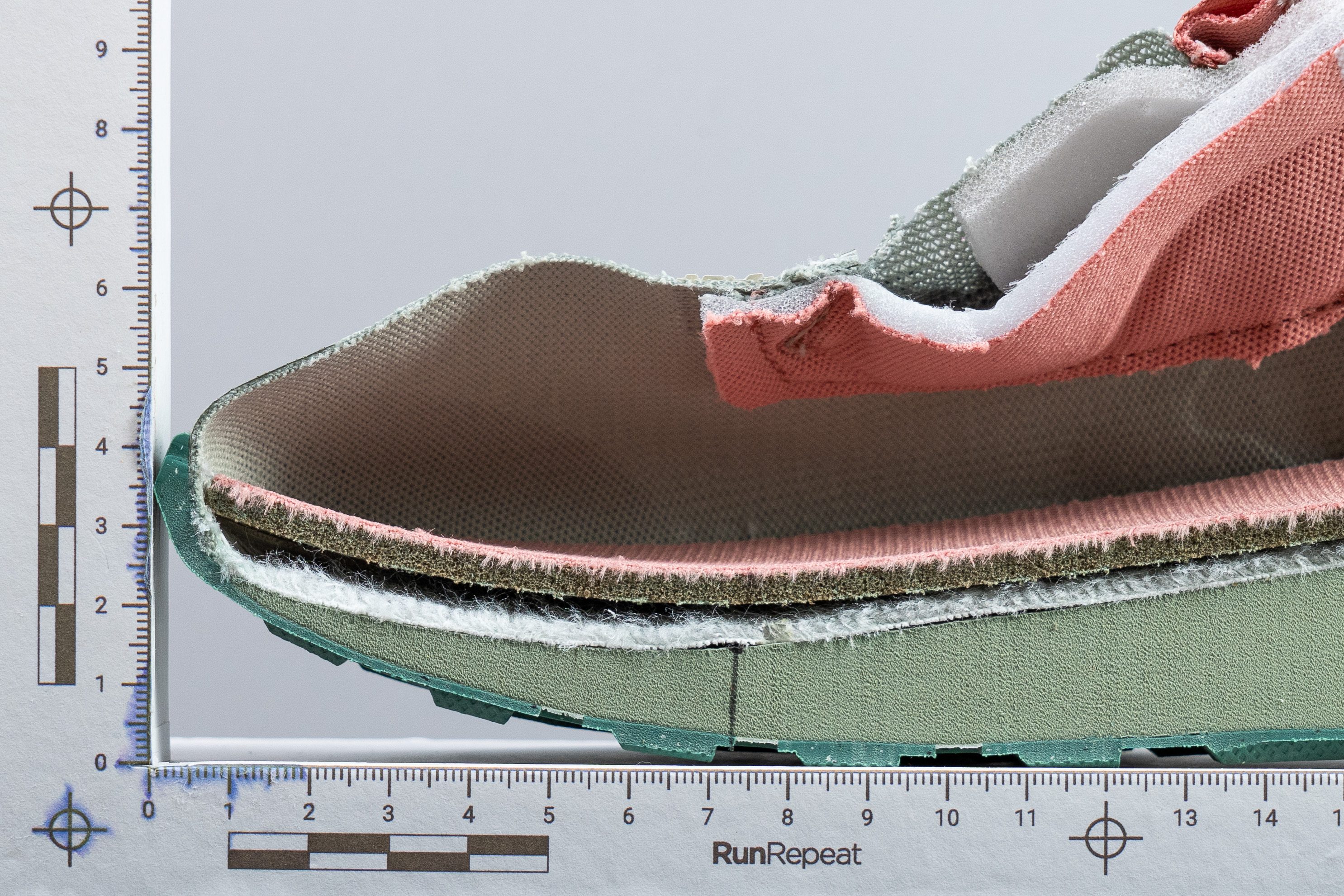
Size and fit
Size
Nike Juniper Trail 3 fits true to size (57 votes).
Width / Fit
We crafted a gel mold of the shoe's interiors and measured the widest part, which came in at 96.3 mm. This measurement aligns with the average trail shoe, confirming that Nike designed this model with versatility in mind.
In our opinion, the fit strikes a balance—perfect for those who don’t fall into extreme width categories, offering a universally accommodating design.

| Juniper Trail 3 | 96.3 mm |
| Average | 95.6 mm |
Toebox width
We found the toebox width impressive at 76.1 mm, making this shoe ideal for those who value ample room for natural toe splay. On the flip side, it might feel slightly wide for individuals with narrow feet.
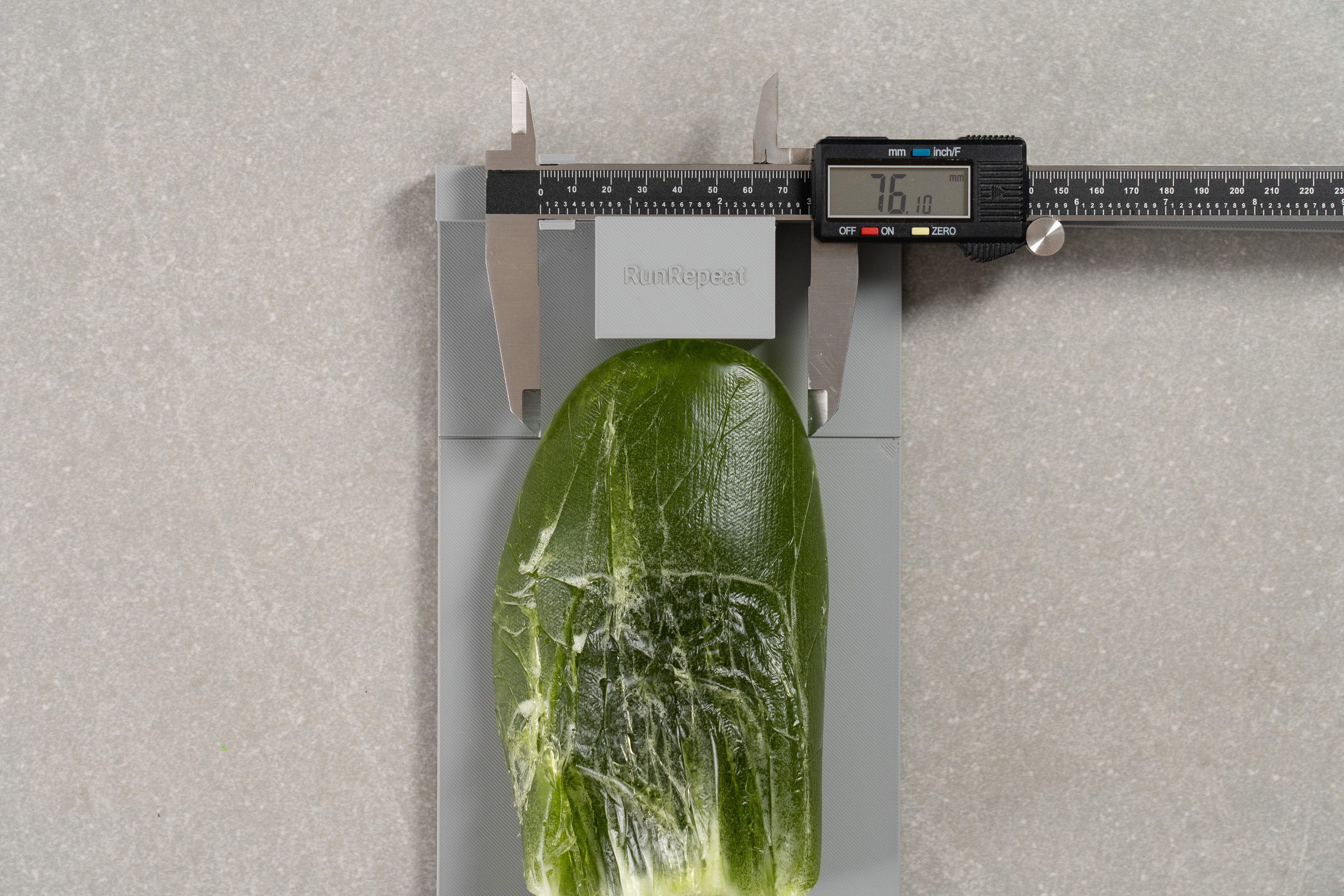
| Juniper Trail 3 | 76.1 mm |
| Average | 74.6 mm |
Toebox height
Height-wise, we found the upper slightly limited, measuring just 25.5 mm.
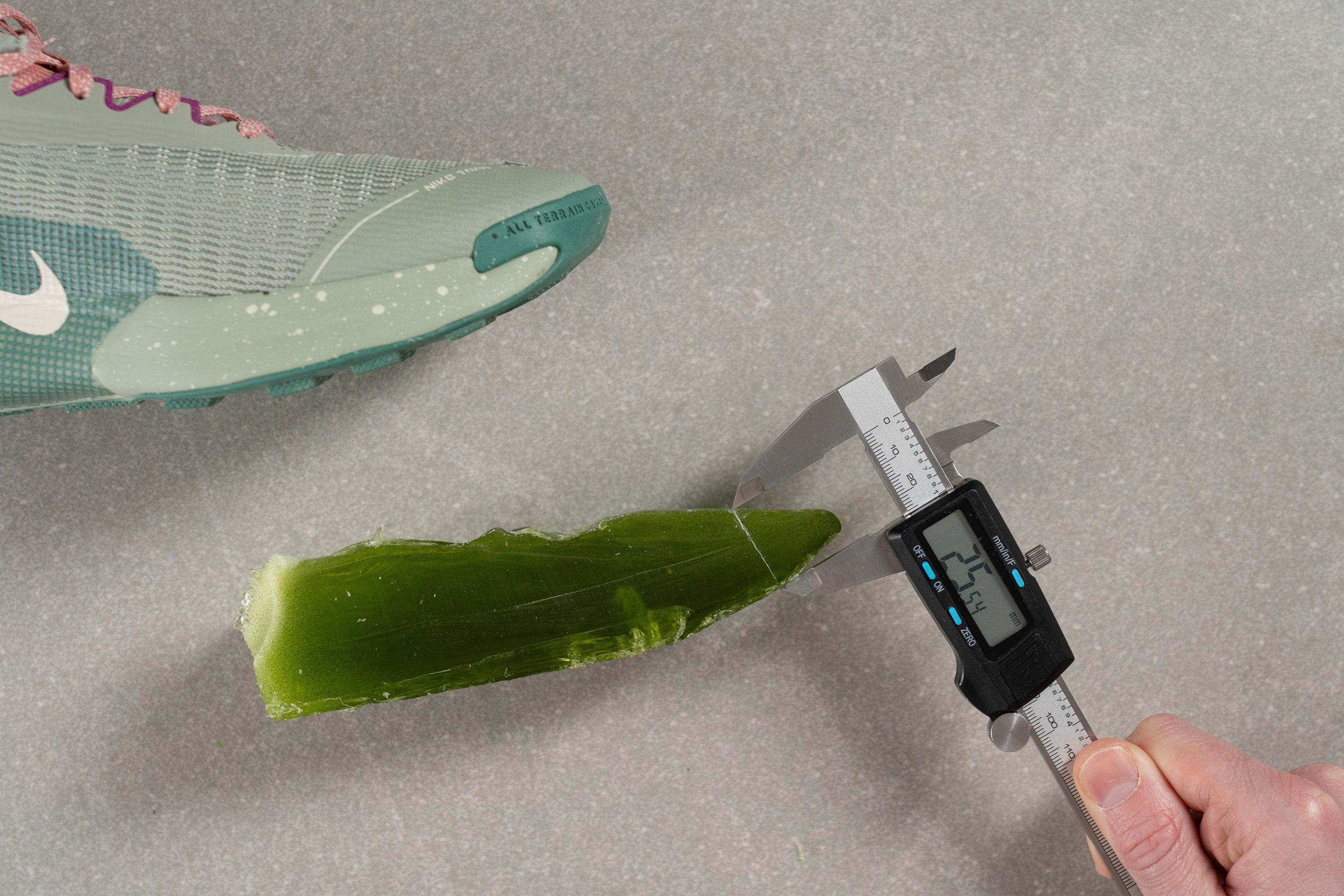
| Juniper Trail 3 | 25.5 mm |
| Average | 27.1 mm |
Traction / Grip
Lug depth
Back to the outsole. This is a door-to-trail running shoe, meaning it’s not built for heavy mud or challenging trails.
With shallow, 2.6 mm lugs, it’s tailored for easier paths, dirt roads, and the occasional stretch of asphalt back home. And we determined that it performs smoothly for these moderate surfaces.
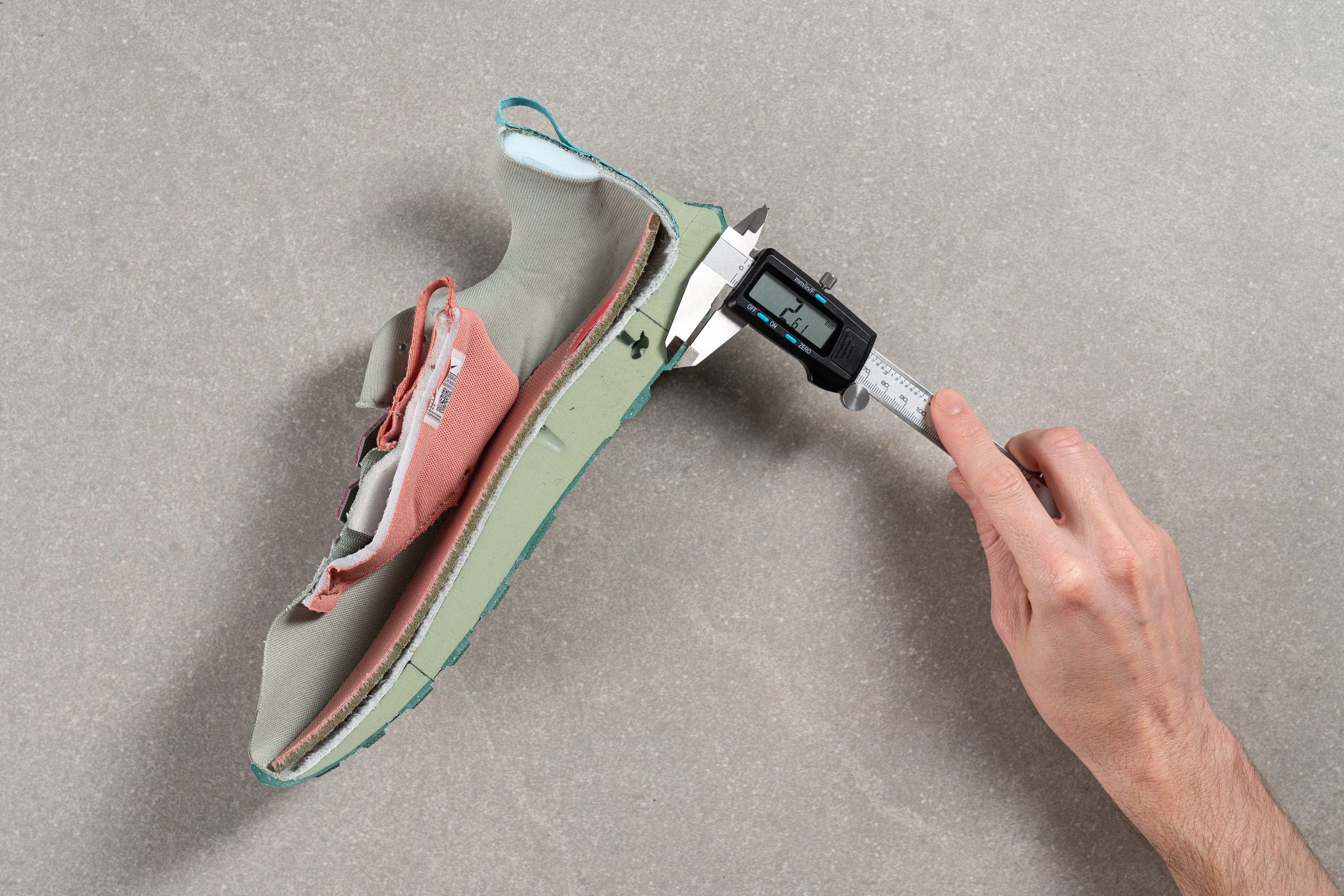
| Juniper Trail 3 | 2.6 mm |
| Average | 3.5 mm |
Outsole design
Does the outsole look familiar? That’s right, it borrows some design cues from the Nike Invincible 3. Segmented pods in the forefoot and heel are separated by deep flex grooves and a pronounced longitudinal channel for enhanced flexibility.
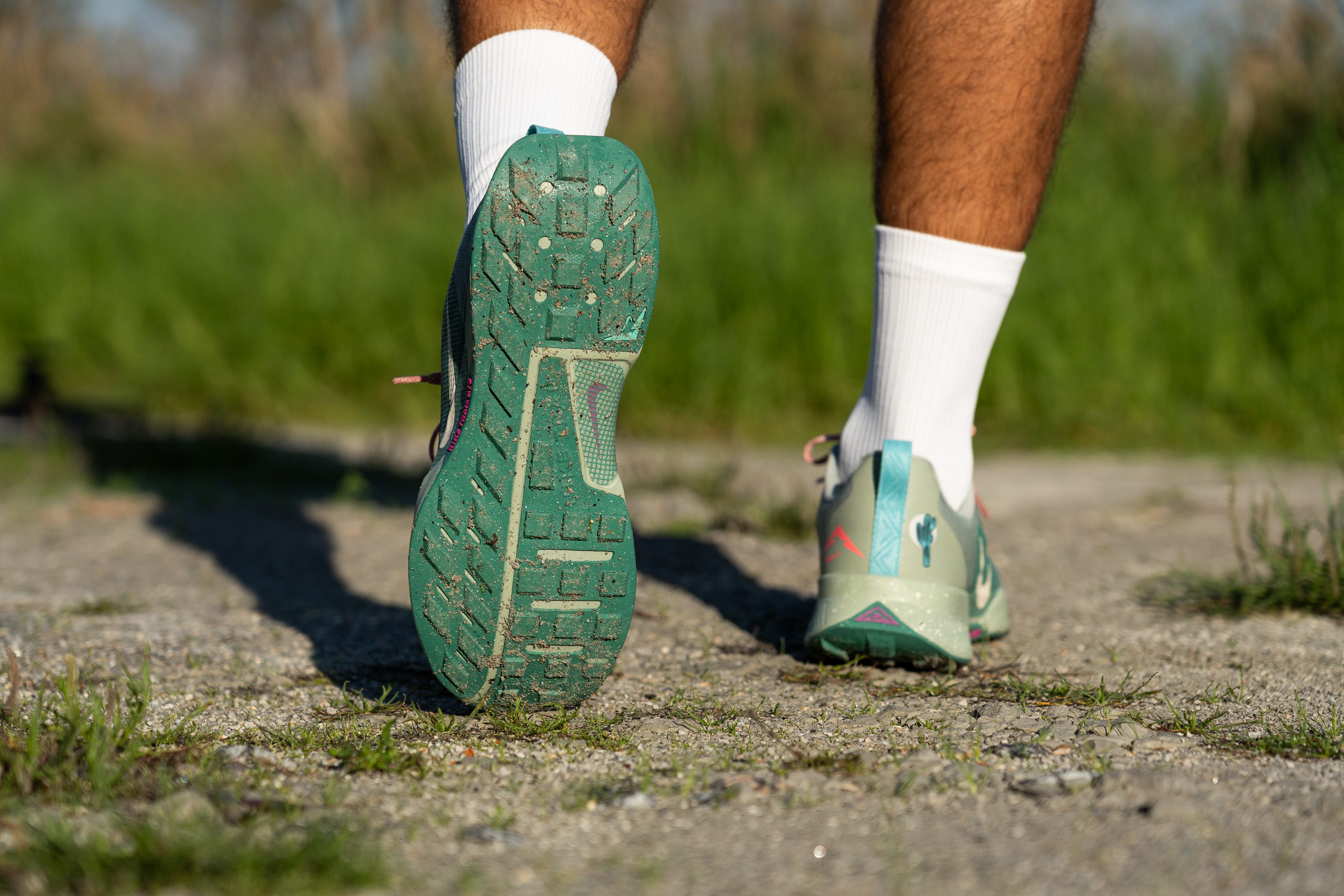
Flexibility / Stiffness
One of our initial concerns with the Juniper Trail 3 was its potential longitudinal stiffness, especially given its high torsional rigidity. After testing, we discovered that it takes just 14.2N to bend the shoe to 30 degrees, showing that Nike has clearly prioritized flexibility in this model.
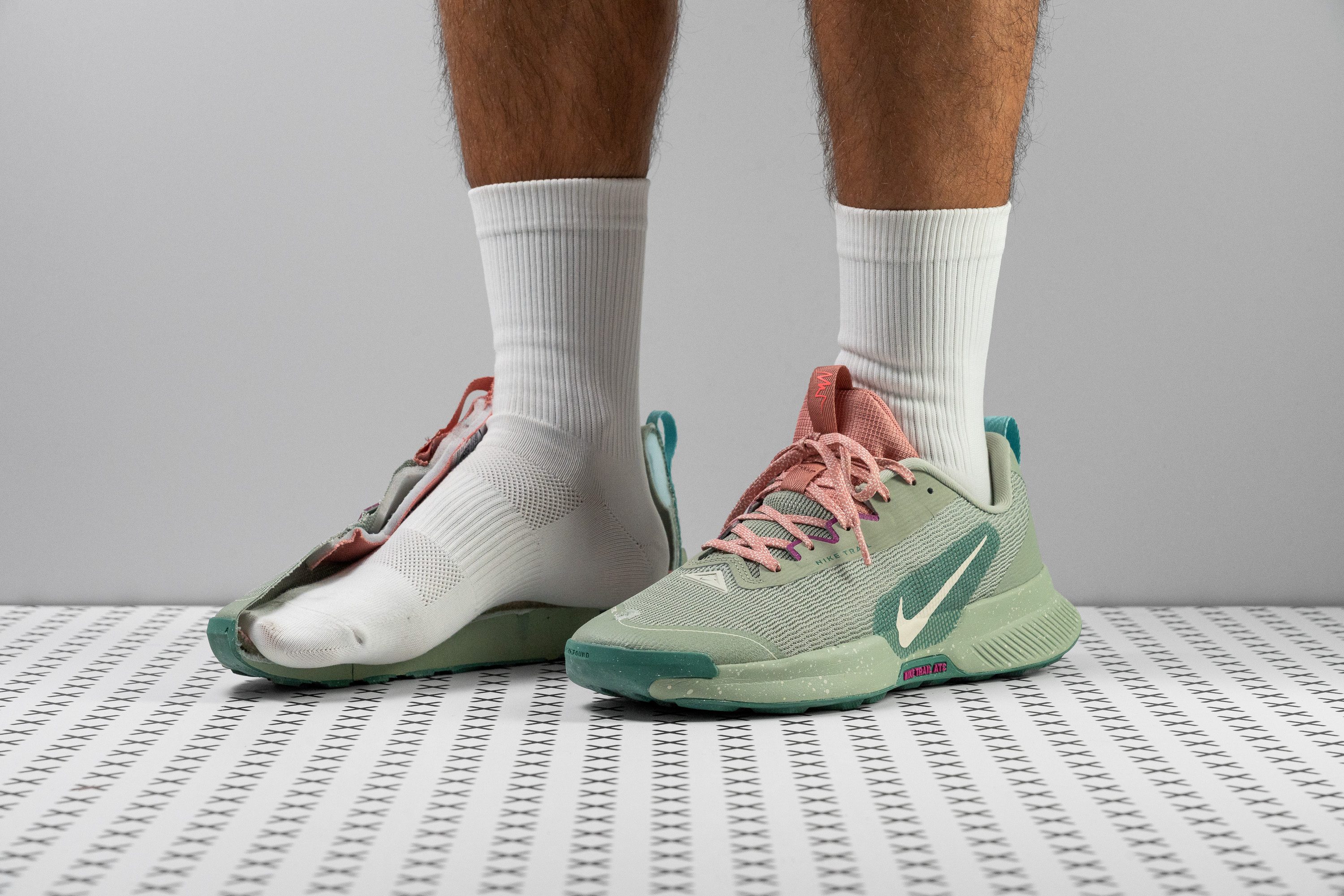
| Juniper Trail 3 | 14.2N |
| Average | 14.7N |
Weight
A thinner outsole brings a clear advantage—it creates a lighter running shoe. At 10.2 oz (288g), the Juniper Trail 3 not only outshines most of its peers in weight but also sheds a bit compared to its predecessor, which came in at 10.8 oz (306g). That's great news.
This weight reduction is certainly felt while running and will be appreciated by anyone embarking on long outdoor adventures.
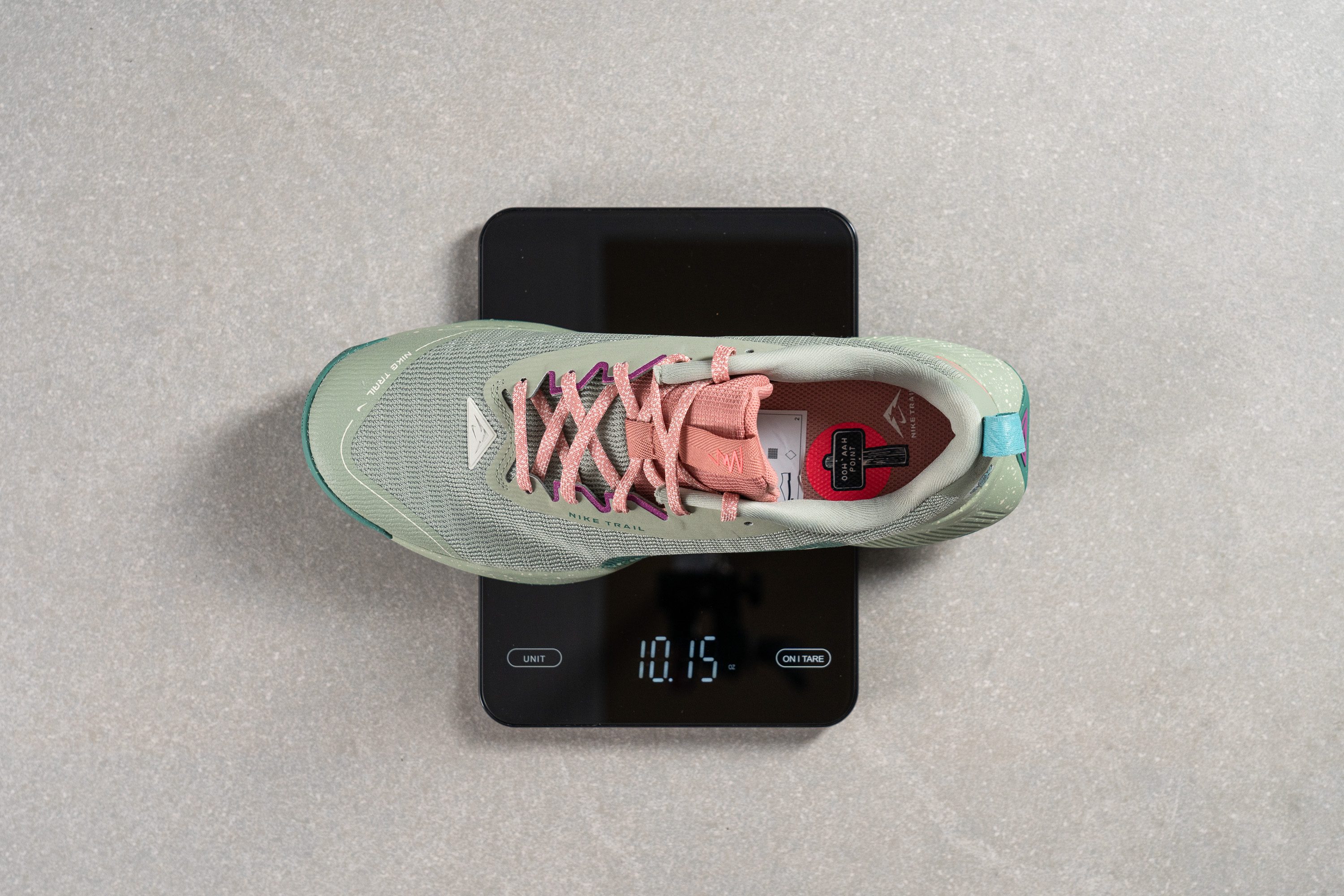
| Juniper Trail 3 | 10.2 oz (288g) |
| Average | 10.2 oz (289g) |
Breathability
We started our journey with the Nike Juniper Trail 3 by assessing its breathability—a factor less critical for trail shoes than for road models but still important for most runners.
Unfortunately, for those eyeing this shoe for summer outings, ventilation is quite limited. Our lab tests revealed a 2/5 rating, which is notably low for hot-weather use.
Nike opted for a thick engineered mesh upper, likely intended to boost (we hope so) durability. However, it seems a bit excessive here, as barely any light passes through—far from what we consider breathable.

Using the microscope, we uncovered the real reason: the mesh is exceptionally dense and lacks ventilation holes, not even the tiniest ones, making air escape nearly impossible.
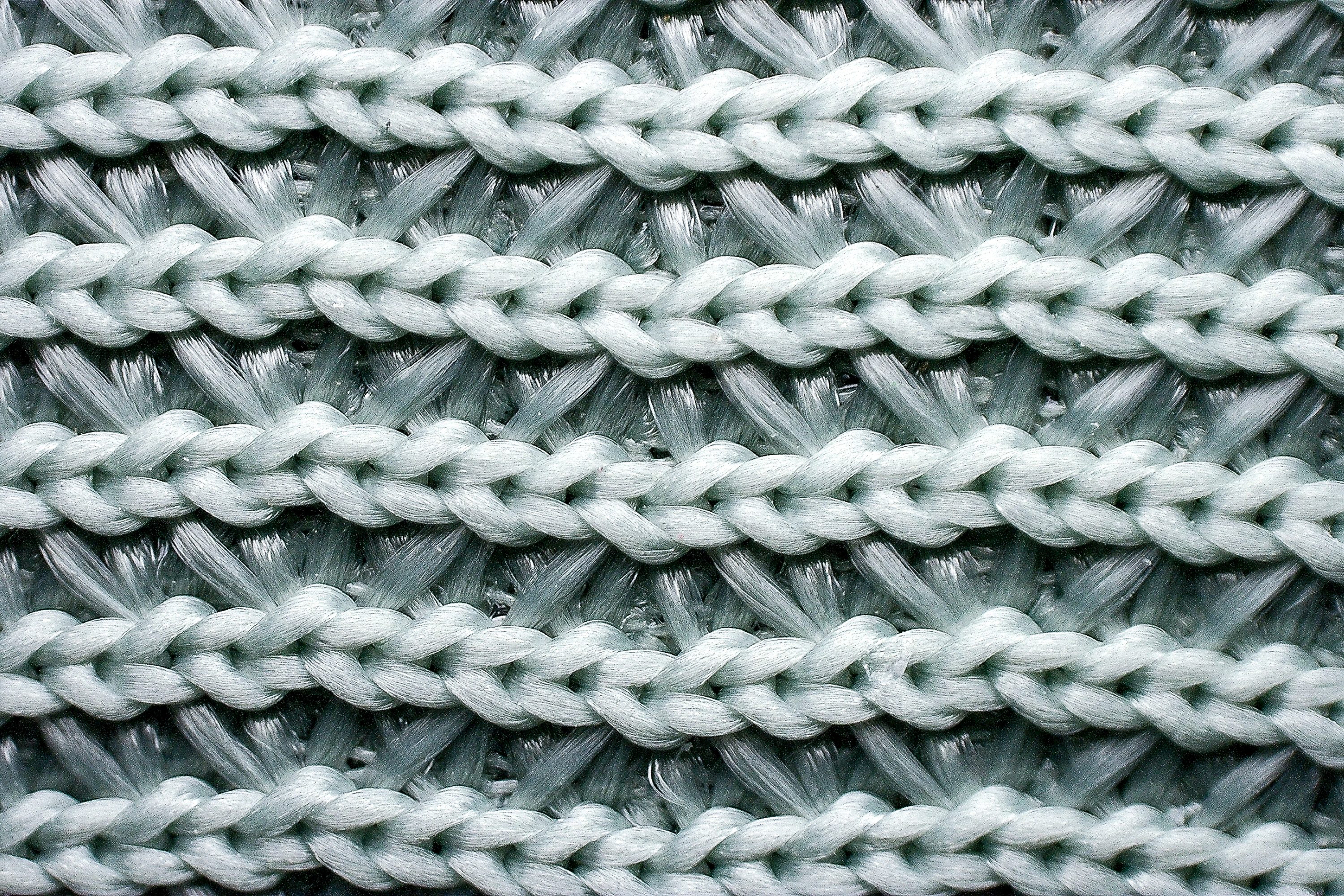
On the bright side, the upper quality and comfort is impressive for such an affordable shoe.
And for those planning to use this model in cooler months or winter conditions, we believe it’s a solid choice with minimal downsides.
| Juniper Trail 3 | 2 |
| Average | 3.2 |
Stability
Lateral stability test
The softer foam in this model did raise initial concerns about potential wobbliness compared to the previous generation. However, that was never an issue—we remained in complete control while running, feeling balanced and steady.
In summary—as neutral runners, we found no problems with stability. However, for those requiring extra support, a shoe with a broader midsole might be more suitable.
Torsional rigidity
The previous Juniper Trail received some complaints for its steel-like torsional rigidity, which some runners found excessive. Nike has partially addressed this with a slight improvement, giving the Juniper Trail 3 a 4/5 rating in torsional flexibility.
In our view, a more flexible build would still enhance this shoe's performance, but we believe this update is a step in the right direction.
| Juniper Trail 3 | 4 |
| Average | 3.6 |
Heel counter stiffness
Designed primarily with heel strikers in mind, it was no surprise in our lab tests that the heel counter of this shoe proved to be exceptionally stiff, scoring 4/5 on our rigidity scale.
Fortunately for those opting to purchase the Juniper Trail 3, Nike has thoughtfully added a generous layer of luxuriously-soft padding around the heel, enhancing comfort and making the firm support in this area feel more forgiving.
| Juniper Trail 3 | 4 |
| Average | 3 |
Midsole width - forefoot
We mentioned earlier that runners needing extra support might benefit from a wider shoe, so now it's time to back that up with measurements.
In the forefoot, we took 113.6 mm using our digital calipers—a solid width for a door-to-trail shoe, but far away from stability shoes.
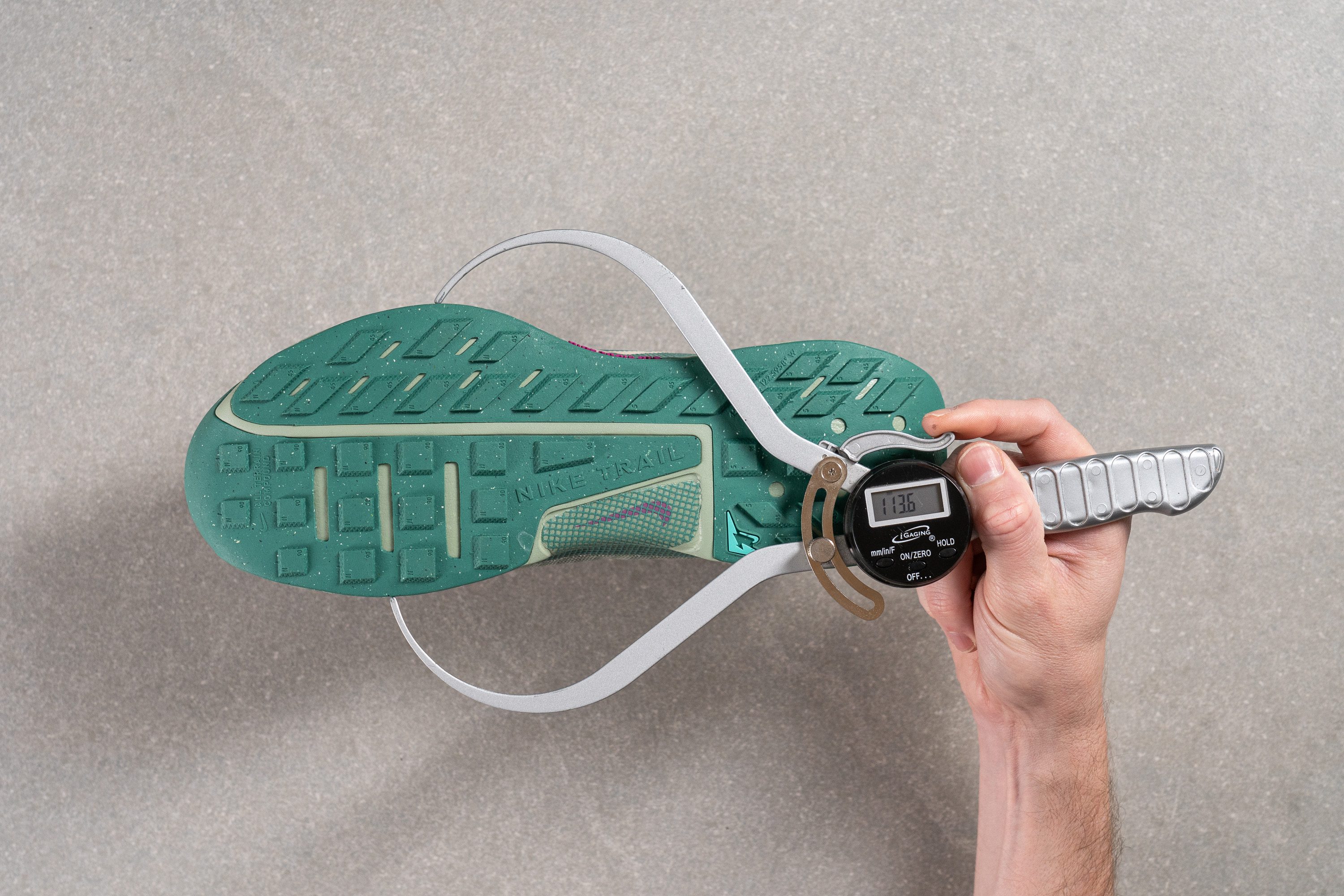
| Juniper Trail 3 | 113.6 mm |
| Average | 112.8 mm |
Midsole width - heel
The heel design follows the same approach, measuring 89.6 mm—a very standard width, as if Nike aimed to craft a shoe that suits most buyers. In our view, they succeeded.
However, since this model caters heavily to rearfoot strikers with its stiff heel counter and high drop, a bit more width in this area would’ve been a welcome addition.
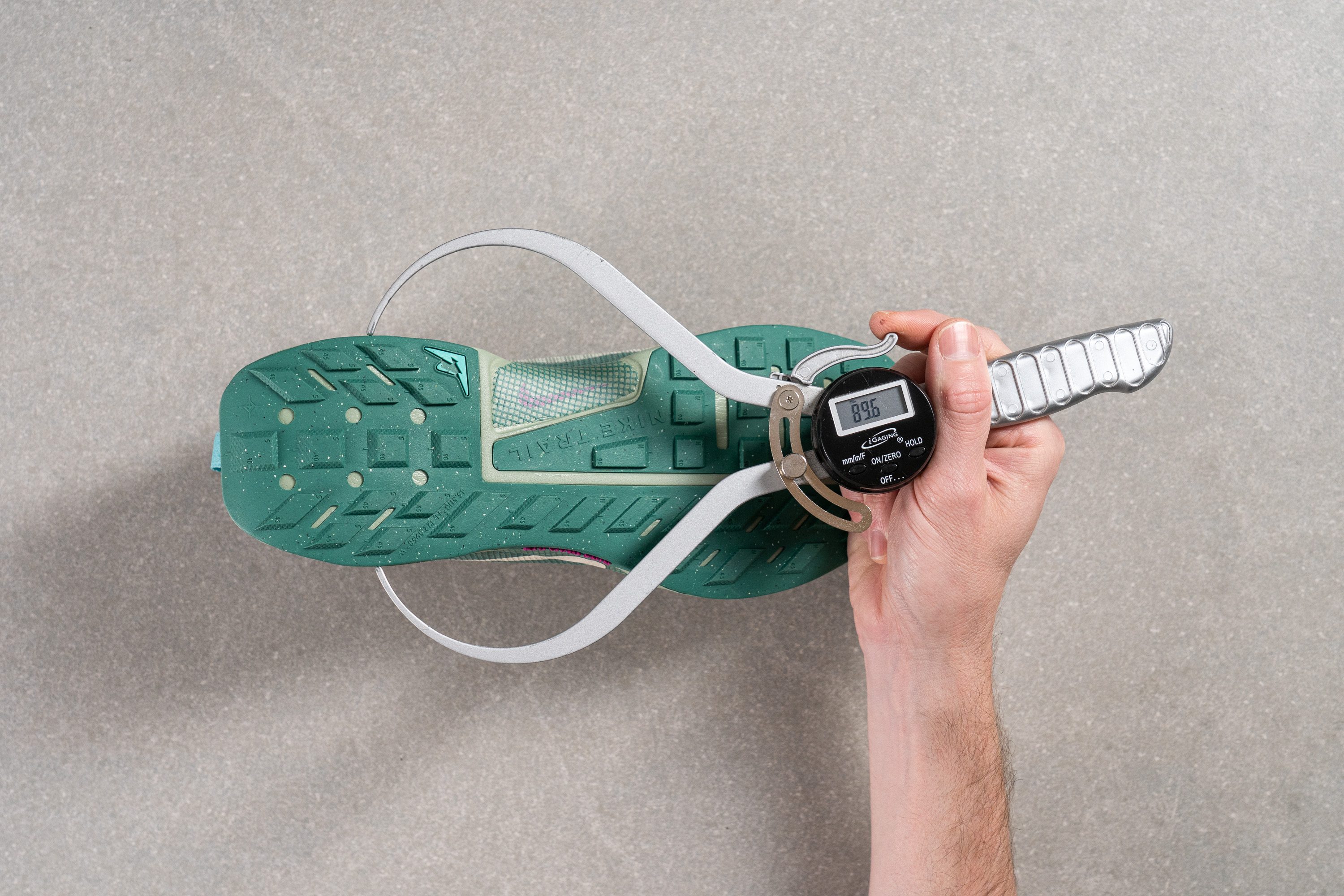
| Juniper Trail 3 | 89.6 mm |
| Average | 89.9 mm |
Durability
Toebox durability
The lack of ventilation holes in the upper should, in theory, give the Juniper Trail 3 a noticeable durability advantage—so we fired up the Dremel to see if it holds up.
The shoe achieved a fair 3/5, which we found slightly underwhelming for a non-breathable upper. Our assessment suggests that the TPU protective overlay at the toe took the majority of the wear, but the dense mesh held its own decently. It's not a bad score, but we expected more from this shoe.
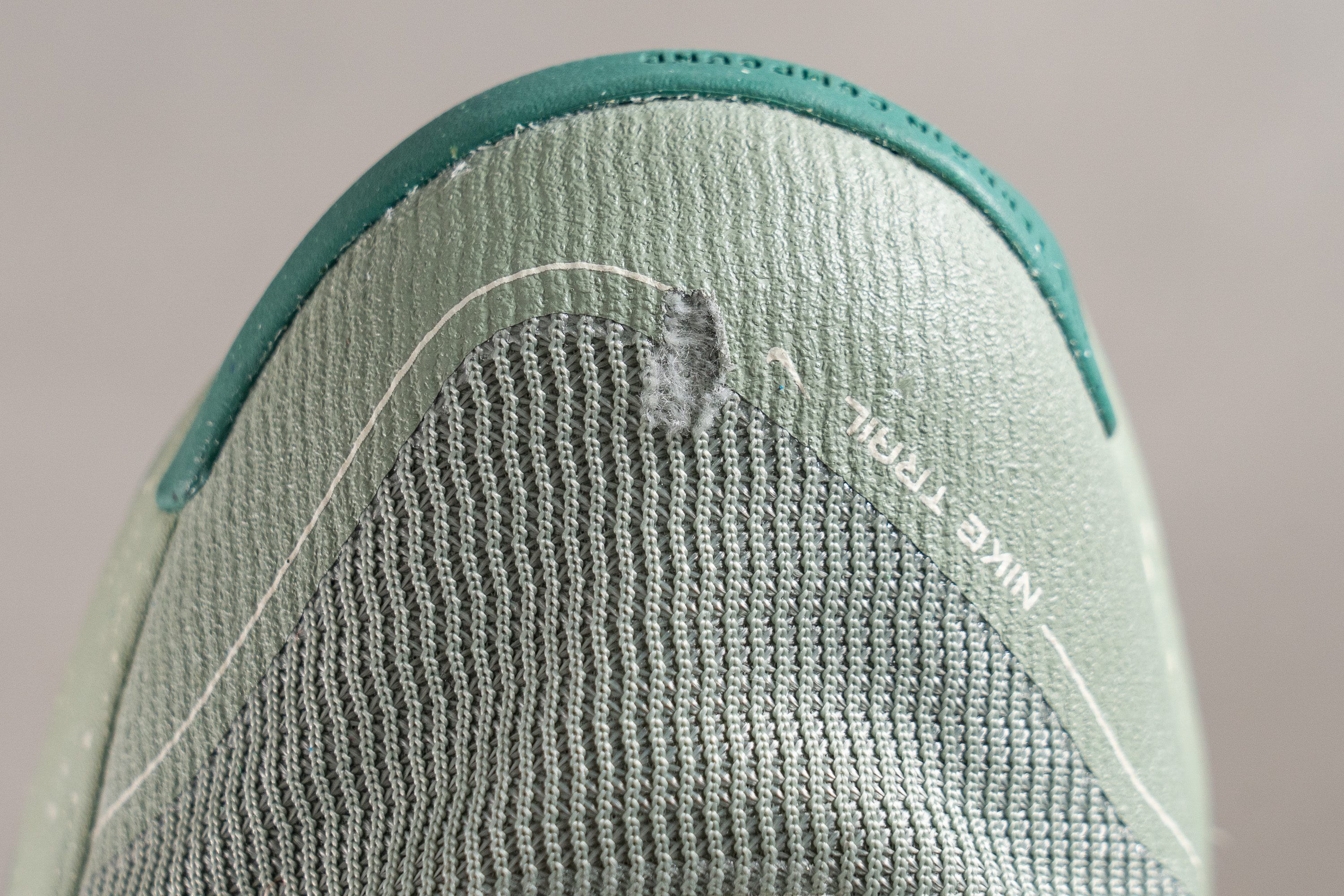
| Juniper Trail 3 | 3 |
| Average | 3.1 |
Heel padding durability
The heel padding was a true disappointment—it barely survived the Dremel test, ending up with a surprisingly huge hole that we didn’t anticipate. In our experience, such a quick breakdown in this area is a serious flaw.
For runners who rarely experience heel wear, this may not pose an issue. However, in our view, those who often find holes in their heel padding should avoid the Juniper Trail 3.
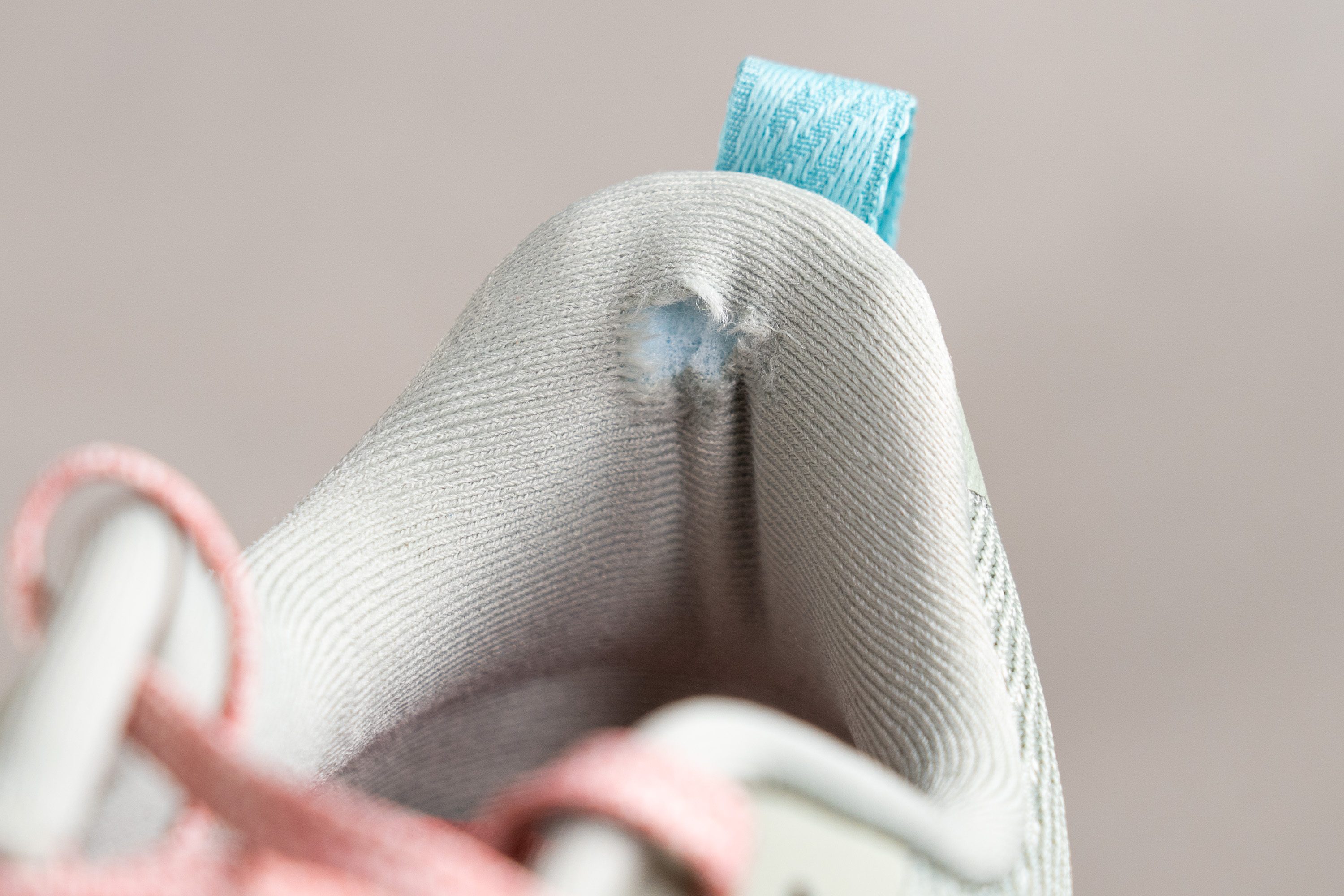
| Juniper Trail 3 | 1 |
| Average | 3 |
Outsole hardness
The toebox held up well, but the heel area raised some concerns here in the lab.
Moving to the outsole, we began by testing the All Terrain Compound’s hardness, which registered at 87.0 HC on our Shore C durometer.

This reading suggests that Nike aims for durability with this outsole—favoring longevity over maximum grip. In our experience, this approach aligns with its positioning as an affordable option, where the balance usually leans toward rugged resilience rather than world-class traction.
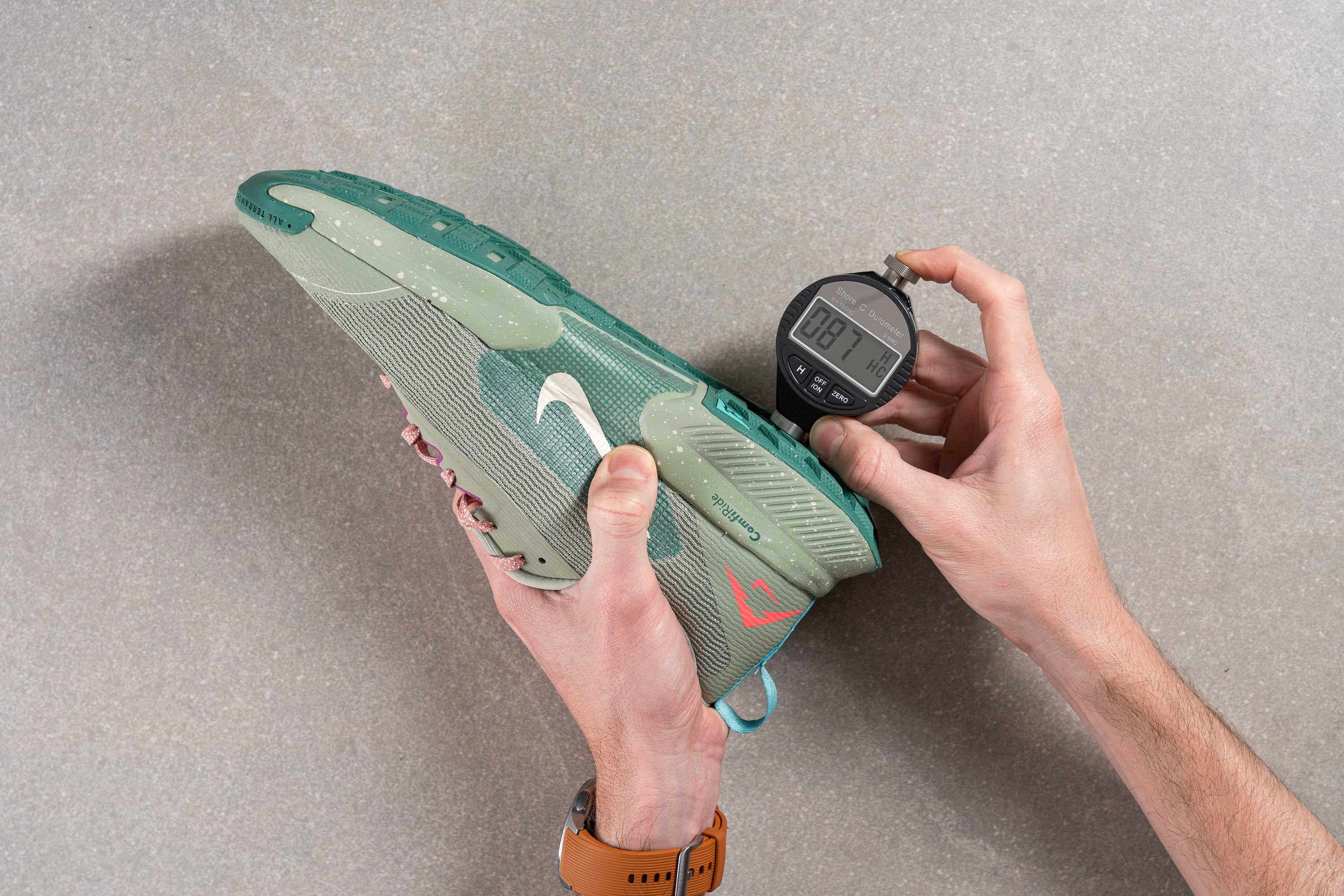
| Juniper Trail 3 | 87.0 HC |
| Average | 85.8 HC |
Outsole durability
To evaluate the durability of the outsole, we performed our third Dremel test—also the final one for today in the lab. We all need a break, including our hard-working tools!
The outcome aligned perfectly with our expectations: just 0.8 mm. Why is that? Well, it exactly matches the Peg Trail 5, as both share the same ATC outsole material. And hey, this consistency in results is reassuring for us too!
Nike added a fun detail in the lugs—each one displays its specific angle, like “45” or “90,” in the bottom right corner, depending on the lug’s shape.

| Juniper Trail 3 | 0.8 mm |
| Average | 0.9 mm |
Outsole thickness
Thickness-wise, the outsole measures a slim 1.6 mm, which is noticeably thinner than most trail shoes. This design choice makes sense to us, as the JT3 aims to be a versatile road-to-trail shoe, performing comfortably on various surfaces, including asphalt.
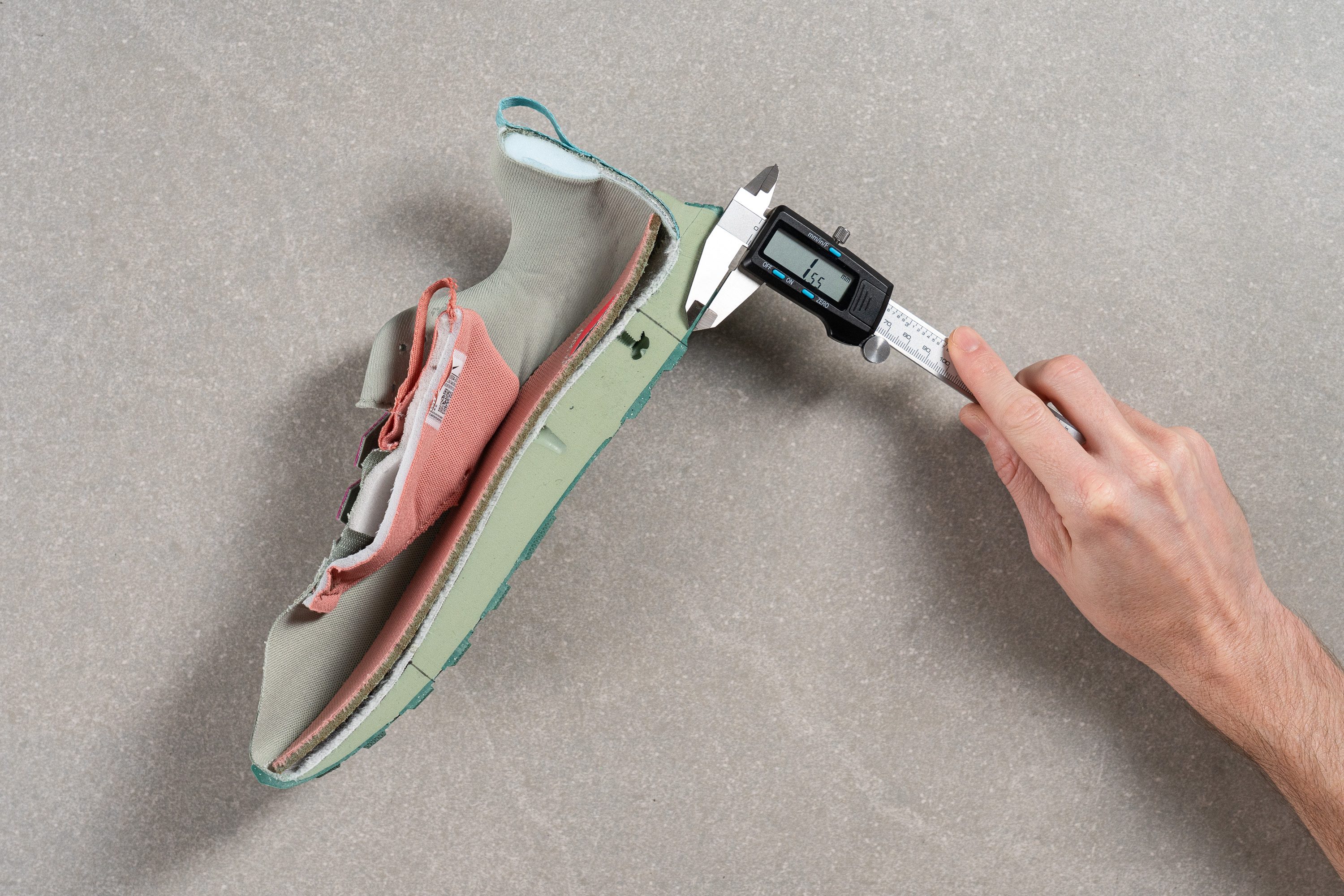
| Juniper Trail 3 | 1.6 mm |
| Average | 2.2 mm |
Misc
Insole thickness
We found the insole to be 3.9 mm thick—slightly thinner than what we typically encounter in the lab.
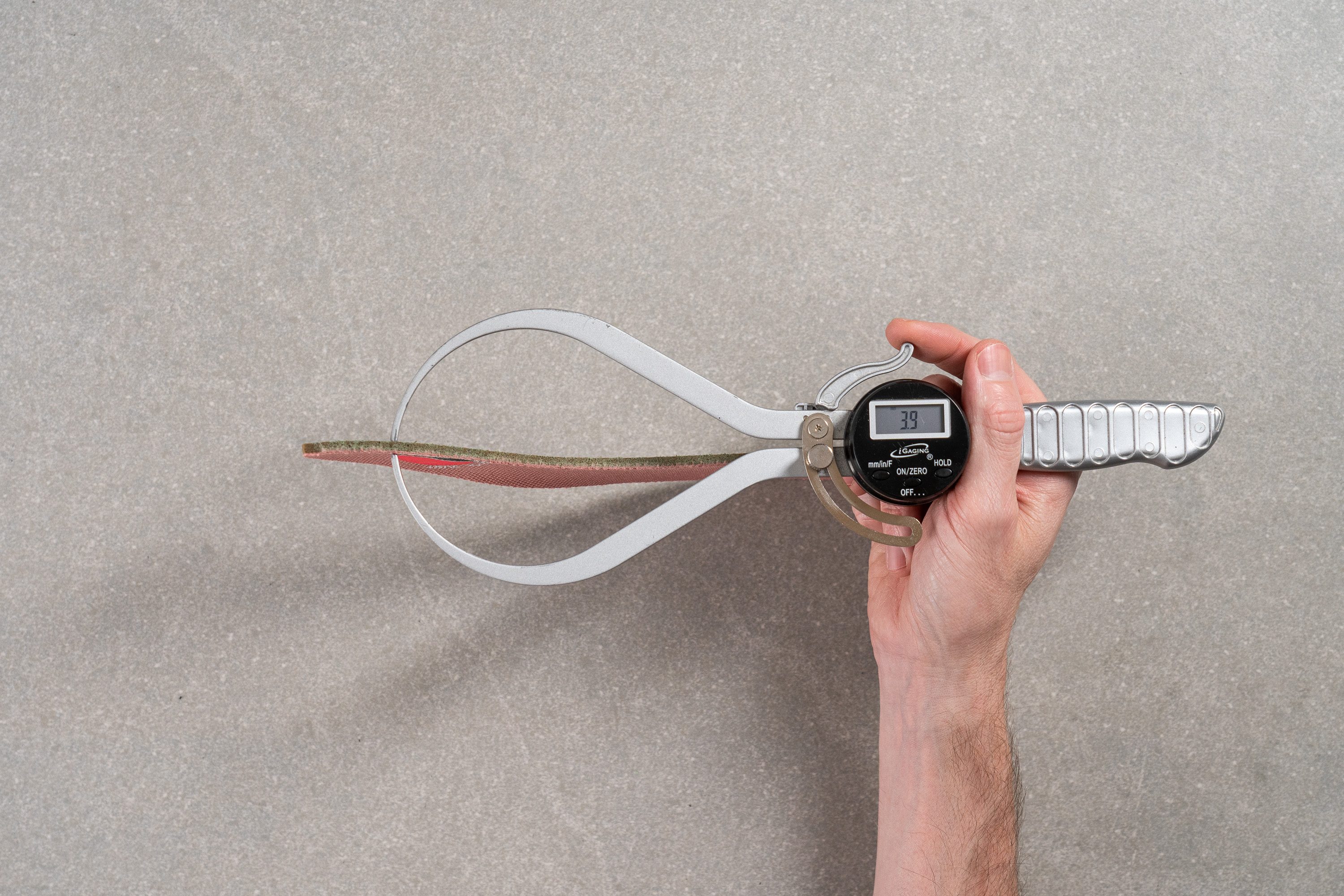
| Juniper Trail 3 | 3.9 mm |
| Average | 4.7 mm |
Removable insole
The stock insole is quite basic, so you won’t miss much by swapping it out—except for just another fun sticker!
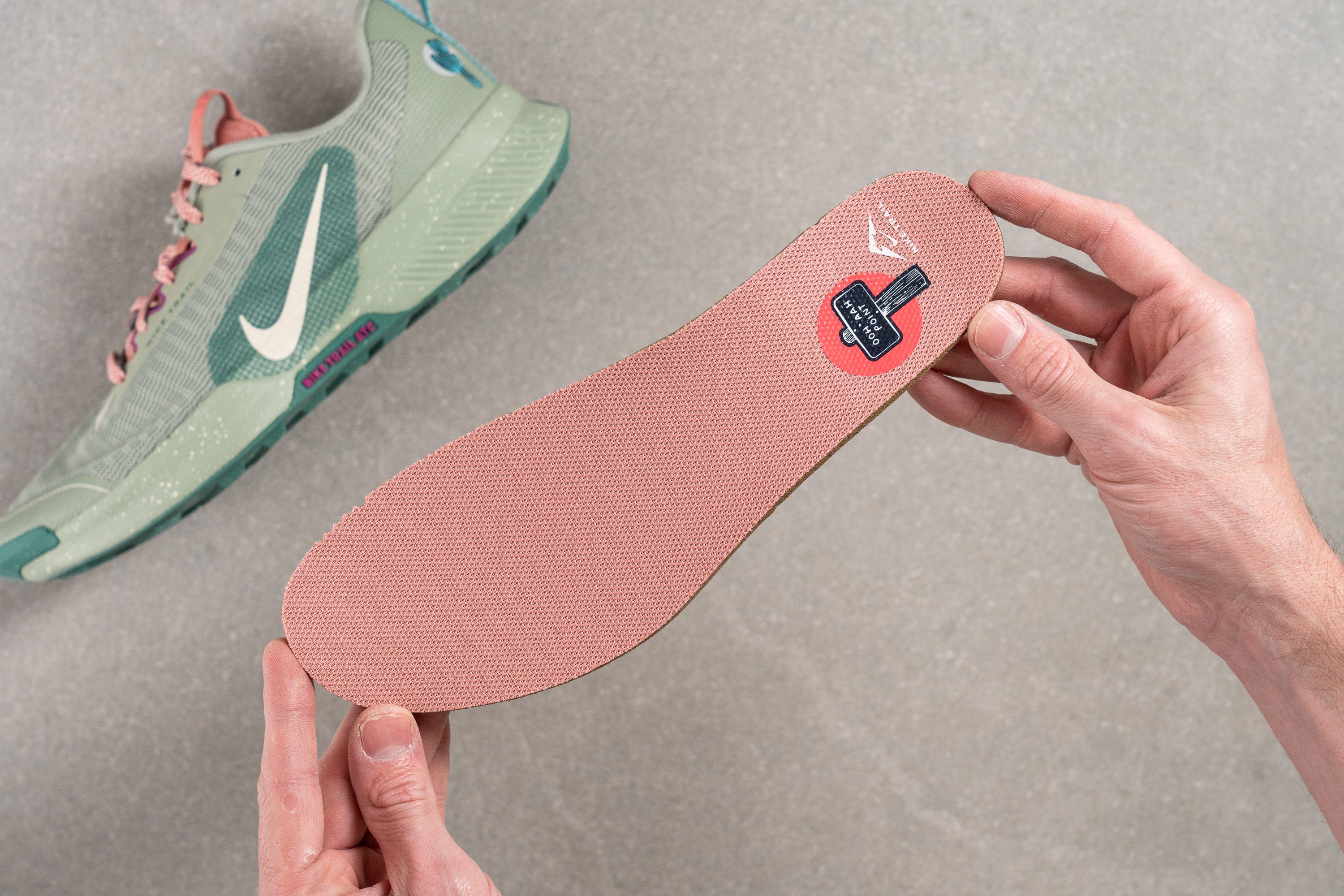
| Juniper Trail 3 | Yes |
Midsole softness in cold (%)
We found that the ComfiRide foam firmed up by only 22.8% after 20 minutes in the freezer—a solid result in our tests. This matters, as this shoe’s limited ventilation makes it much better suited for winter temps.
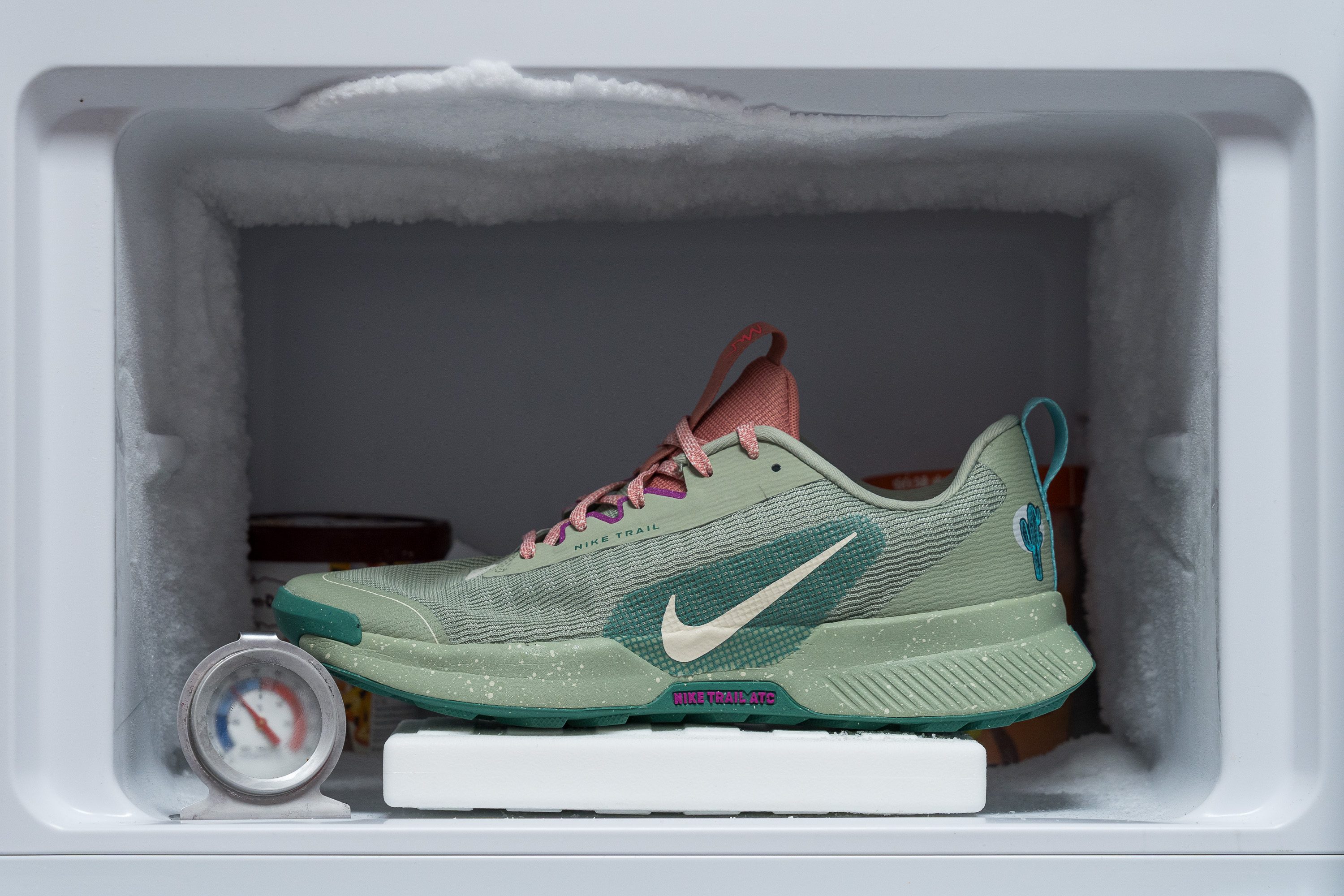
| Juniper Trail 3 | 23% |
| Average | 26% |
Reflective elements
We’ve tested countless trail running shoes here in the lab—most of them priced far above the Juniper Trail 3—that lack any reflective elements. So, finding them in this budget-friendly model feels like a big win.
| Juniper Trail 3 | Yes |
Tongue padding
We found the tongue exceptionally comfortable, with 7.2 mm of padding from two slabs of foam—providing ample cushioning for all-day wear without being too heavy.

The tongue includes a handy loop to keep it in place, a crucial feature since it’s not attached to the sides. On top of that, the lacing system is all that we wanted for the Juniper's price—simple yet effective. Naturally, it lacks the Flywire design seen in higher-end Nikes, but it gets the job done.
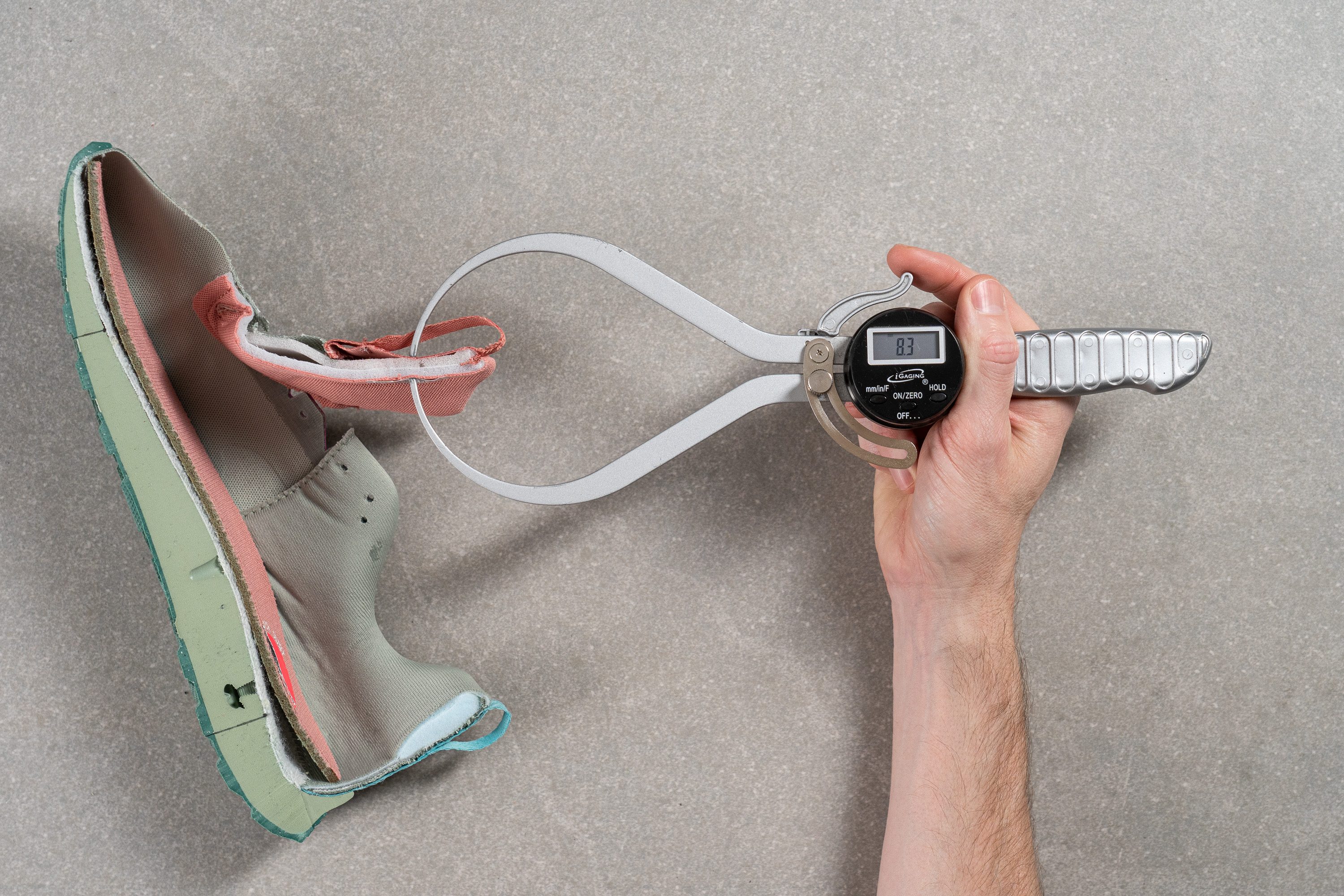
| Juniper Trail 3 | 8.3 mm |
| Average | 6.4 mm |
Tongue: gusset type
For under a hundred bucks, we really can't ask for much more. We understand that a gusseted tongue—one of those premium-boosting features Nike reserves for pricier models—would have been fantastic for the JT3, but it's fine!

| Juniper Trail 3 | None |
Price
If we had to choose the standout strength of the Juniper Trail 3, it would be its value. Staying under the $100 mark is rare for trail shoes—which are typically pricier than road models—but Nike has achieved it here.
| Juniper Trail 3 | $90 |
| Average | $153 |
Heel tab
The heel sports a finger-loop tab, adding a cool, trail-ready vibe to the Juniper Trail 3. And we can’t overlook the cactus decal on this unique colorway we purchased for our lab review!

| Juniper Trail 3 | Finger loop |

